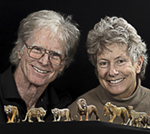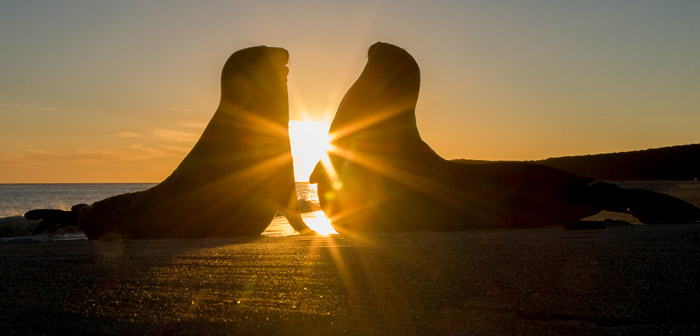
Trip Report: Falklands 2017
We were lucky enough to visit the Falklands twice in 2017. Our first trip was a fairly short one, as we visited Saunders, Carcass, and New Island when we were on the Joseph Van Os Ultimate Antarctica trip. Our zodiac landings were fun, and too brief for us, and we were anxious to return about a month later when we hosted our Falklands Bird and Wildlife Photo Tour. For Falklands-based trips we stay on land, at the various guest homes, rather than on a ship. Often our group of eight were the only people at a location, and even at Sea Lion Island, where there is a larger lodge, there were fewer than 15 tourists, including us.
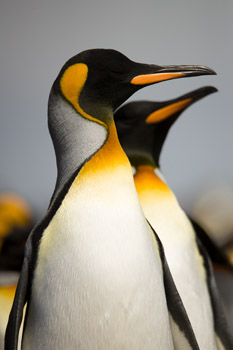 The advantage of a land-based trip is you can always be photographing, regardless of the weather. In bad winds or bad seas, when zodiacs can't land, land-based photographers can still shoot. Travel from one island to another is by plane, FIGAS, the Falkland Island Government Air Service, and in the very, very rare times when FIGAS can't fly it doesn't matter -- you're already on an island so you just stay there, and continue photographing!
The advantage of a land-based trip is you can always be photographing, regardless of the weather. In bad winds or bad seas, when zodiacs can't land, land-based photographers can still shoot. Travel from one island to another is by plane, FIGAS, the Falkland Island Government Air Service, and in the very, very rare times when FIGAS can't fly it doesn't matter -- you're already on an island so you just stay there, and continue photographing!
We had a great group and, over-all, very good weather. The Falklands' Spring was a cold and wet one, but the weather changed by the time we arrived and our shooting, for the most part, was quite clement. We had one day with very powerful winds, but they could be avoided by just working some of the cliff-side colonies instead of the flats that were exposed to the wind.
Unlike past trips here, this time I did far more video than I did shooting stills. The video was fun (I used a Really Right Stuff video head) and captured scenes with more impact than a photo could, but the culling of images afterward was an enormous workload. Still, I hope to make several promo videos showcasing what you can expect on a Falklands trip.
Here's the report!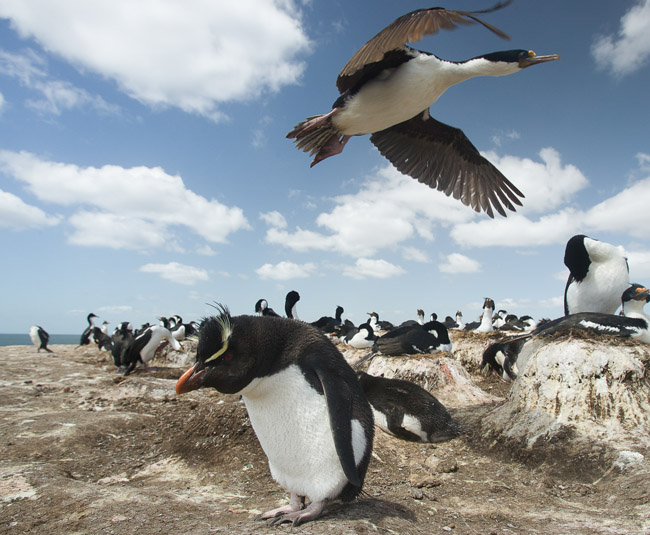
Day 1. Stanley, Falkland Islands
Everyone arrived in Punta Arenas after some major setbacks, which included one couple, Don and Brenda, having their luggage stuck in Miami as they flew down a day early – to avoid problems! Another participant, Eric, had his flight delayed in Washington, DC, and thus missed his connection to Santiago, Chile. Eric had to spend the night in Miami, but his luggage arrived, and Don and Judy’s luggage reached Punta Arenas with Eric. He picked it up and joined Don, who waited outside the luggage area with a taxi driver I had located who spoke English, and who was to help them get inside and explain the lost luggage/and recovery if Eric didn’t. With that, all our problems were over the day before we flew to Stanley, the capital of the Falklands. We arrived in late afternoon to a sunny sky and pleasant temperatures, a nice contrast to the preceding weeks of reportedly miserable Falklands’ weather. After an early dinner, everyone organized for our first field outing, tomorrow, to Volunteer Point.
Day 2. Volunteer Point
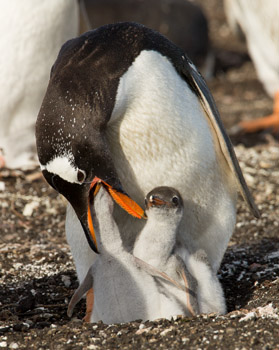 We left our hotel at 7:30AM for the 2-3 hour drive to Volunteer Point, the site of the largest King Penguin colony in the Falklands. I’ve been traveling here for the last twenty years off and on, and the contrast in the road and driving conditions now, compared to the cross-country struggle we did in our first few years, made this trip relatively pleasant. There were still bog holes to avoid, and innumerable bumpy roads, but the days of jacking up vehicles, using metal planks to ford swamps, and climbing steep hillsides are over.
We left our hotel at 7:30AM for the 2-3 hour drive to Volunteer Point, the site of the largest King Penguin colony in the Falklands. I’ve been traveling here for the last twenty years off and on, and the contrast in the road and driving conditions now, compared to the cross-country struggle we did in our first few years, made this trip relatively pleasant. There were still bog holes to avoid, and innumerable bumpy roads, but the days of jacking up vehicles, using metal planks to ford swamps, and climbing steep hillsides are over.
Although we had intended on devoting all of our time to the King Penguins, the Gentoo Penguins nesting nearby had newly hatched, tiny and cute chicks, and these diverted our attention. Most birds were still on eggs, but a few had chicks that were large enough to barely fit beneath their brooding parent. Several, however, had virtually new hatchlings, complete with egg-teeth that the hatchlings use to slice an escape hatch from the egg. Gentoos lay two eggs, a few days apart, to insure that one of thehatchling survives, and if there is enough food, so, too, will the other. Right now, conditions seemed so favorable that both chicks looked of equal size, and healthy.
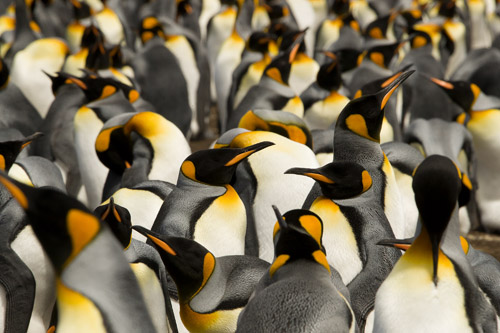 King Penguins were either incubating, or still waiting to lay their single egg. Mary almost videoed an egg-transfer, as these Penguins incubate their egg (and very young chicks) as the eggs rests upon the adults feet. At transfer, an egg is carefully passed from one bird’s feet to the other, without the egg touching the ground, or doing so only for a moment. Dick, who remained with a pair who appeared ready to do the transfer, saw this, although the birds turned away at the critical moment,
King Penguins were either incubating, or still waiting to lay their single egg. Mary almost videoed an egg-transfer, as these Penguins incubate their egg (and very young chicks) as the eggs rests upon the adults feet. At transfer, an egg is carefully passed from one bird’s feet to the other, without the egg touching the ground, or doing so only for a moment. Dick, who remained with a pair who appeared ready to do the transfer, saw this, although the birds turned away at the critical moment,
Kings have a three year cycle, as their single chick takes over one year to mature. Eggs laid now, in December, would hatch in January and the chick will be fed throughout the remainder of the summer and fall. In winter, adults return to sea 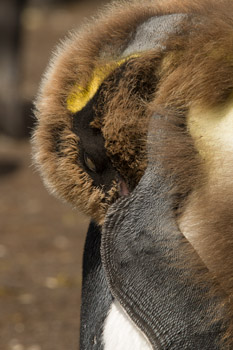 and only occasionally visit the colony to feed their chicks, who creche up to keep warm and to survive. By the following summer those that survive are molting and are ready to head to the water. We filmed these, some with shaggy brown coats that completely covered the chick in a woolly-looking coat, while others had wispy beards that barely concealed the adult plumage emerging from beneath.
and only occasionally visit the colony to feed their chicks, who creche up to keep warm and to survive. By the following summer those that survive are molting and are ready to head to the water. We filmed these, some with shaggy brown coats that completely covered the chick in a woolly-looking coat, while others had wispy beards that barely concealed the adult plumage emerging from beneath.
Mary, Don, and Brenda made it down to the sandy beach, an emerald-colored bay that seems more appropriate for the tropics than the temperate subarctic. Birds strolled the white sands, and a few bathed or played in the surf. At 2PM we were scheduled to head back to town, and fortunately the skies had begun to cloud cover and the temperature to drop. The best shooting was over.
On our return to town we stopped to photograph the unique Stone Runs, a river of rocks that are the relic traces of glacial movement. The exact origin, or explanation, for the Runs is still somewhat unclear, but the rocks may have slid down glacial ice and melted through, but from the area these streams do indeed look like rivers … but of rocks. We reached our lodge by 5:30PM, under a light overcast.
Day 3. The Cape
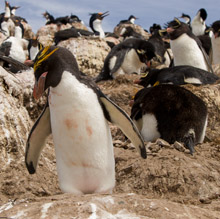
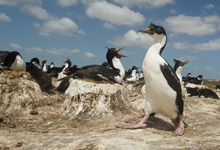
Macaroni Penguin; King Cormorant
We left at 7:30 for the nearly three hour drive to the Cape where we hoped to find Macaroni Penguins, as well as the expected Rockhoppers and King Cormorants. When we arrived I did a quick survey at one colony where I apparently missed two, as Ann later discovered two Macronis, one with a fairly good size chick and one brooding an egg. In total, we had 10 Macaronis, a promising increase from two years ago.
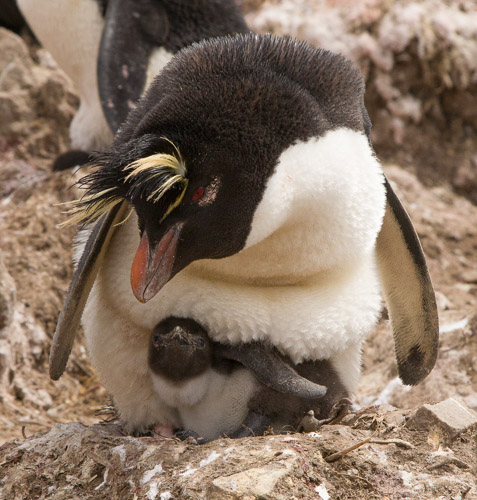
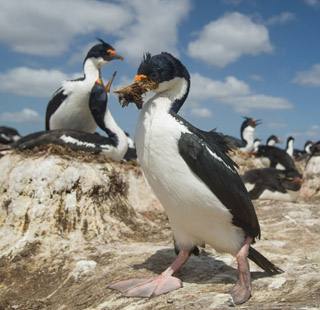 Southern Sealions were hauled out on the grassy hilltop, but I was too involved with the birds and missed any shots. Rockhoppers had tiny chicks, and the birds were quite close and unconcerned. King Cormorants had several colonies, and Mary spotted some tiny ‘snake babies,’ the skinny-necked chicks, but I only saw eggs. Using a wide-angle and lying along a pathway, Idid some wonderful video and stills as birds paraded by, many carrying grassy clumps, moss, or strands of kelp.
Southern Sealions were hauled out on the grassy hilltop, but I was too involved with the birds and missed any shots. Rockhoppers had tiny chicks, and the birds were quite close and unconcerned. King Cormorants had several colonies, and Mary spotted some tiny ‘snake babies,’ the skinny-necked chicks, but I only saw eggs. Using a wide-angle and lying along a pathway, Idid some wonderful video and stills as birds paraded by, many carrying grassy clumps, moss, or strands of kelp.
We were scheduled to leave at 2, but the shooting was too good and we paid for an extra hour, which was all we needed to complete an incredible day.
Day 4. Carcass
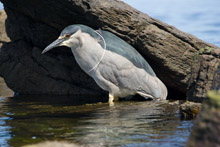
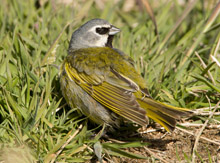

Black-crowned Night Heron; Black-throated Finch; Cobb's Wren
We were lucky enough to get the first FIGAS flight to Carcass, with all of us in one plane, and with our luggage arriving in mid-afternoon. The tide was falling as we arrived, although by very late afternoon the tide had rolled back in to the end of the beach. We found three different Oystercatcher nests, two Blackish and one Pied. Mary and Ann had a great shoot with a Falkland Snipe, that bathed in a small pool. At one point, a Magellanic Penguin walked passed one of the Black Oystercatcher nests and both birds attacked, poking and squawking , and driving the bird away. Eric had found a roosting/sleeping group of Pied Oystercatchers, and when I arrived there were 21 birds sleeping on the beach. They were completely unconcerned, only piping alarms when Striated Caracaras sailed by.
Steamer ducks had chicks, quite small but nonetheless diving underwater at times; a lone white chick of a Kelp Goose followed the hen constantly; Black-crowned Night Herons nested, and my highlight was a Heron that was virtually oblivious to me, and eventually caught a good-sized fish. We had the complete contingent of birds here – Kelp and Upland Geese, Crested Ducks and Steamer Ducks, Dolphin Gulls, Striated Caracaras, Black-throated Finches, Long-tailed Meadowlarks, Falkland Thrushes … a spectacular day.
The afternoon/evening concluded for us when Mary and I treated Don’s torn ear, as he slipped on a rock and his tripod ripped a good hunk of flesh from the ear. After dinner, Don headed back out for some low-light scenic shots.
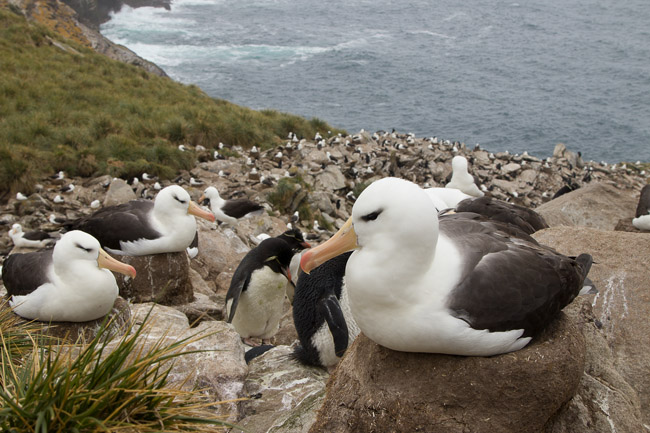
Day 5. Carcass and West Point
Before breakfast I scouted out a spot where I’d seen the tiny Grass Wren in the past, and I was lucky enough to find an adult feeding two hidden but fledged chicks, at 7:55, minutes before breakfast. Afterwards we boarded the new Catamaran boat for the hour trip to West Point for a nice colony of Black-browed Albatross and Rockhopper Penguins. I was pleasantly surprised to be greeted by a very old friend, Allen White, who was my cabin mate on my very first Antarctica trip where the two of us guided. Allen went on to guide for Zeaghrams Expeditions for 10 years, traveling the world, but his career guiding was cut short when the zodiac, stern loaded, was swept beneath the landing area as the sea receded, trapping Allen’s leg between zodiac and ship when the sea rose. It was a bad break.
Allen and our boat crew drove us up to the rookery where we spent the next six hours. I spent a long time at a small colony while Mary and the rest of the group 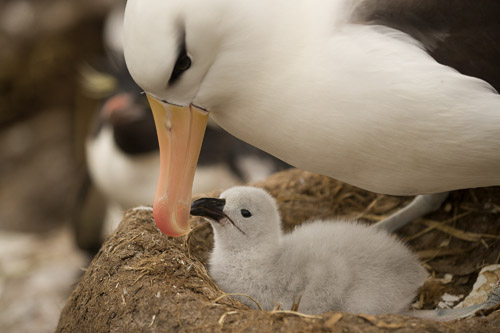 was at another, where they spotted several eggs that were in the process of hatching. One egg had hatched completely, with a wet chick beneath the adult, while the other eggs were in frustrating, tantalizing stages of hatching, with either open holes or half-opened shells, with the chick still inside. This was the first time we’ve been in the Falklands during hatching, and although Mary spent nearly the entire day waiting, the process, apparently, is a slow one that cannot be rushed!
was at another, where they spotted several eggs that were in the process of hatching. One egg had hatched completely, with a wet chick beneath the adult, while the other eggs were in frustrating, tantalizing stages of hatching, with either open holes or half-opened shells, with the chick still inside. This was the first time we’ve been in the Falklands during hatching, and although Mary spent nearly the entire day waiting, the process, apparently, is a slow one that cannot be rushed!
By late afternoon a heavy fog rolled in, wetting us down and dropping the light. At 4 we headed back to the ship for a cruise searching for dolphins, but none showed, and we arrived at the lodge around 6PM.
Day 6. Carcass
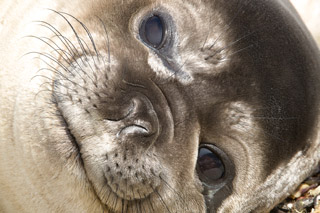 This was one of those absolutely great days prompting me to consider the Falklands as one of my absolute favorite destinations. Some of the group left after breakfast for a drive across the island for Elephant Seals. They enjoyed the morning, getting one young pair of males fighting in the surf.
This was one of those absolutely great days prompting me to consider the Falklands as one of my absolute favorite destinations. Some of the group left after breakfast for a drive across the island for Elephant Seals. They enjoyed the morning, getting one young pair of males fighting in the surf.
Meanwhile, prior to breakfast, I again found the Grass Wren and had even better shooting. Afterwards, Ann and I moved slowly up the beach where we photographed both Oystercatchers, ducks and geese, and, to our surprise, two weaner Elephant Seals. On the way back Ann spooked a Blackish Oystercatcher off the nest, with chicks, but without any harm, and later that afternoon …. I’ll get to that great shoot soon. I found a Falklands Snipe, flushed out by a family of Upland Geese, and the morning rushed by.
 After lunch I tried for my nemesis bird, the Long-tailed Meadowlark. While waiting, out of the wind and warm, I stretched out an slept for an hour, and when I awoke the Grass Wrens had moved up the gully to my present position. For the next 45 minutes I staked out a spot where the two fledglings were hiding and where the adults visited, and got my best shots, ever. As I headed out to check the beach I got my best – for now at least – Meadowlark shots.
After lunch I tried for my nemesis bird, the Long-tailed Meadowlark. While waiting, out of the wind and warm, I stretched out an slept for an hour, and when I awoke the Grass Wrens had moved up the gully to my present position. For the next 45 minutes I staked out a spot where the two fledglings were hiding and where the adults visited, and got my best shots, ever. As I headed out to check the beach I got my best – for now at least – Meadowlark shots.
I was alone and moving at my own, very slow pace, and spent time with a Pied Oystercatcher I hoped would turn her eggs (she didn’t). Moving on, I found the Blackish Oystercatcher with the chicks, and soon after I settled on this Ann joined me. Oddly, alarm calls (piping calls) from Pied Oystercatchers would set these birds on alert, and several times they flew off, circling, before returning. As they returned, birds would walk right by me … and with me sitting low and still, I knew I was accepted.
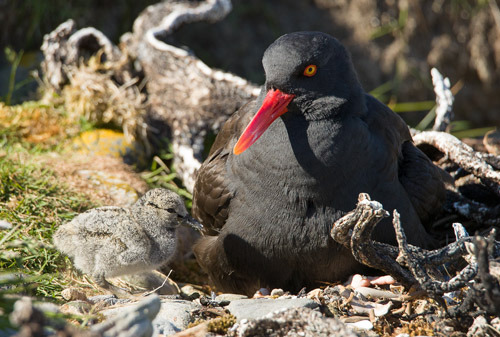
As the afternoon continued I moved a bit closer, getting better views and shots of the two chicks, while the adults did a nest exchange and eventually settled, sleeping, only feet away from me. When I slowly backed off, finished shooting, the 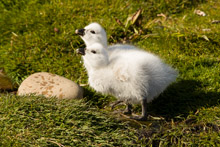 birds didn’t move. A family of Kelp Geese were nearby and also accepted me, giving me frame-filling shots of the chicks and the hen with her brood. The intimacy of these encounters was just spectacular, and as I slowly passed oblivious birds on my way home I conclude that the Falklands has to be one of my all-time favorite locations, anywhere. The wildlife is at tame as the Galapagos, but the freedom one has here, to spend all day with one subject if one wishes, cannot be duplicated.
birds didn’t move. A family of Kelp Geese were nearby and also accepted me, giving me frame-filling shots of the chicks and the hen with her brood. The intimacy of these encounters was just spectacular, and as I slowly passed oblivious birds on my way home I conclude that the Falklands has to be one of my all-time favorite locations, anywhere. The wildlife is at tame as the Galapagos, but the freedom one has here, to spend all day with one subject if one wishes, cannot be duplicated.
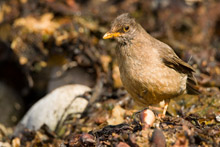
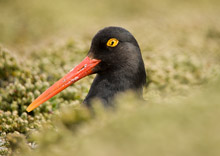
Falkland Thrush; Pied Oystercatcher
Day 7. Carcass to Saunders
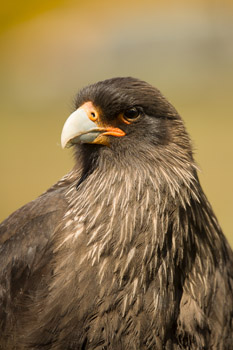 We had another early flight, a ten minute commute from one island to another, which we did in two back-to-back flights. We traveled by landrover to the Neck, had a quick lunch, and in increasingly brooding skies we headed to the Rockhopper and Albatross colonies on the ridge. Rockhoppers were a bit further along than at the Cape, with some birds nearly half the size of the adults. The colony, because of a nest failure two years ago and increasing predation last year and this, is now 25% the size it was four years ago! The Striated Caracaras are a major threat, and if their predation continues it is quite likely that the colony will be wiped out in a few years.
We had another early flight, a ten minute commute from one island to another, which we did in two back-to-back flights. We traveled by landrover to the Neck, had a quick lunch, and in increasingly brooding skies we headed to the Rockhopper and Albatross colonies on the ridge. Rockhoppers were a bit further along than at the Cape, with some birds nearly half the size of the adults. The colony, because of a nest failure two years ago and increasing predation last year and this, is now 25% the size it was four years ago! The Striated Caracaras are a major threat, and if their predation continues it is quite likely that the colony will be wiped out in a few years.
Albatrosses were flying everywhere, and I tried slow motion video – an incredible challenge, as the birds whip by quickly, rarely giving more than 2 or 3 seconds of opportunity. Most often, autofocus caught the background – the colony or the sea – and I missed some incredible opportunities as birds drifted in . Still, by only shooting video, I caught some sequences.
A lone Macaroni Penguin has paired with a Rockhopper, which our JVO trip had a month ago. By 5PM Rockhoppers were coming back in, smashed against the rocks, bouncing off, and eventually gaining access and climbing ashore. A Southern Sealion swam by, body surfing the waves in quite obvious play. By 6:30 the light dropped and it began to rain and we headed to camp.
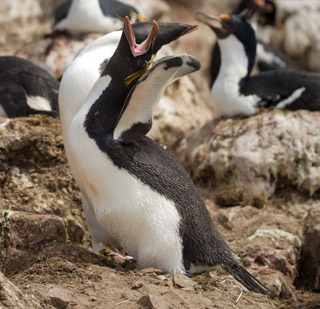
Day 8. Saunders at the Neck
Don headed out at 4:30AM for a sunrise, although the rest of us before bad weather settled in for a part of the morning. By 9:45 or so the rain had stopped and everyone headed out to various locations – some to the rookeries on the hill top, others to the beach, and, for me, to the Rockhoppers to check if or when birds returned earlier than the late evening. Although the shooting was a bit sporadic, birds did arrive throughout the morning.
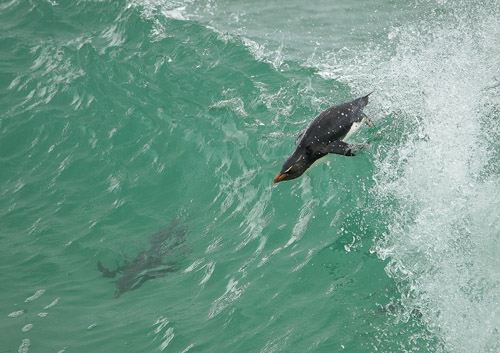
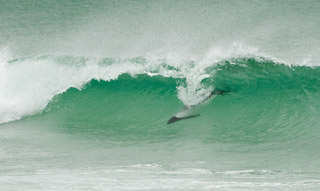
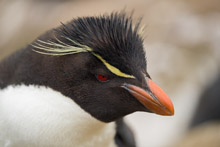
Rockhopper surfing in; Commerson's Dolphin in a curl; Rockhopper
After lunch a storm front moved through, bringing with it some rain and higher winds, but I’d moved out to a distant spot overlooking one of the Rockhopper haul outs where I had found an overhanging ledge. There, I was blocked from both the wind and rain, and when the sun finally shone it was actually quite warm. Most of the rest of the group went to a nearby haul out, where I joined them to help some folks across the rocks, and the shooting was fair – not as good as the evening before. Most worrisome were the high rollers crashing in with the rising tide, and I worried that a sneaker wave might catch us by surprise. None did, but by 6PM the seas threatened to cut off our exit and most folks headed back to camp. I climbed the cliff to visit the Rockhoppers a final time, where I found several Black-browed Albatrosses that joined me on a ledge over-looking the colony. Birds strode up to me as if I were just another bird, and I did some pleasant wide-angle shots of adults with the colony in the background. By 7 clouds cut off the sun and the shooting was over.
Day 9. Saunders and the Settlement
Heavy winds and pounding rain woke us several times during the night but the day dawned clear, a misleading forecast as repeated squalls forced us back inside. Don was caught out in the first one and was soaked, although in the settlement hail had carpeted windowsills with an inch of ice.
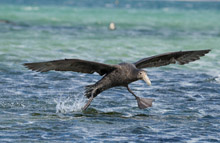 Between squalls most of us photographed Gentoo Penguins, and watched as Skuas stole chicks and Caracaras charged in to the colony, attempting to spook adults from their nest. We were scheduled to visit the other rookery this afternoon but with the threat of more squalls, and marooned there without a vehicle for shelter, we decided to remain at the settlement where, in late afternoon, we photographed Giant Petrels scavenging sheep bones.
Between squalls most of us photographed Gentoo Penguins, and watched as Skuas stole chicks and Caracaras charged in to the colony, attempting to spook adults from their nest. We were scheduled to visit the other rookery this afternoon but with the threat of more squalls, and marooned there without a vehicle for shelter, we decided to remain at the settlement where, in late afternoon, we photographed Giant Petrels scavenging sheep bones.
Day 10. Saunders Rookery
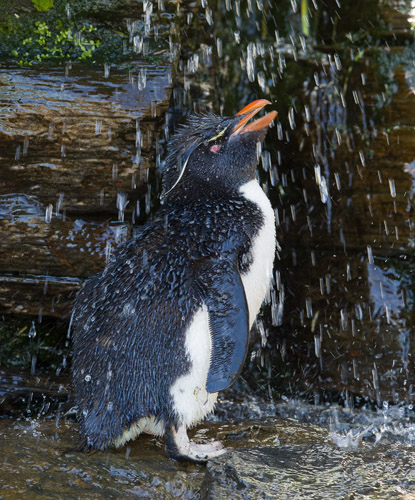
Rockhopper Penguin at 'the shower'
After breakfast we headed to another Rockhopper and Albatross colony, called ‘the rookery, which is the location for a unique feature, The Shower, where Rockhoppers literally shower beneath a small cascading trickle. We had a tremendous and debilitating wind today, but beneath the ridge, where the Albatross nest and where the Rockhoppers shower, and climb uphill, the weather was quite pleasant. Mary checked out the shower early, and reported that it was in shade, so I decided to do video then, since fast shutter speeds would not be a problem.
As it turned out, that was a good move, and everyone eventually came down to shoot the birds in the shade of the ledges. By 2PM or so the shower would be in sunlight, but because of the tiresome wind we decided to be picked up at 3PM, giving us time for another crack at the Giant Petrels.
Yesterday’s Petrels were eating small scraps, giving us plenty of chase scenes when one bird would grab a morsel, and then be pursued by a mob. Today, piles of just-slaughtered sheep guts were dumped into the sea, creating mob scenes of fighting birds but fewer chases. Nonetheless, Mary (who didn’t shoot yesterday’s birds) shot 94gb!

Day 11. Saunders to Sea Lion Island
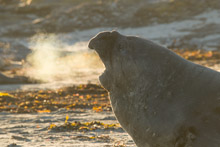 FIGAS, the Falkland Island Government Air Service, was down to just one plane for all their transfers today, and Mary and I were originally scheduled to do a late afternoon flight. Before bedtime last night we were told of a change – we were now leaving at 9, with the rest of the group flying out at 2. This gave us plenty of time to check out some areas, including a lookout point for the Orcas that are now patrolling, looking for seals.
FIGAS, the Falkland Island Government Air Service, was down to just one plane for all their transfers today, and Mary and I were originally scheduled to do a late afternoon flight. Before bedtime last night we were told of a change – we were now leaving at 9, with the rest of the group flying out at 2. This gave us plenty of time to check out some areas, including a lookout point for the Orcas that are now patrolling, looking for seals.
The group arrived by 3 and everyone had plenty of time to shoot a wide variety of subjects. After dinner, hoping for the Orcas, we headed to the beach where over 100 Elephant Seals are hauled out and, at sunset, wrestle, tussle, and fight. Mary and Don did some great backlighted Penguins against a golden sand washed by the setting sun, while I worked on videos of the seals.
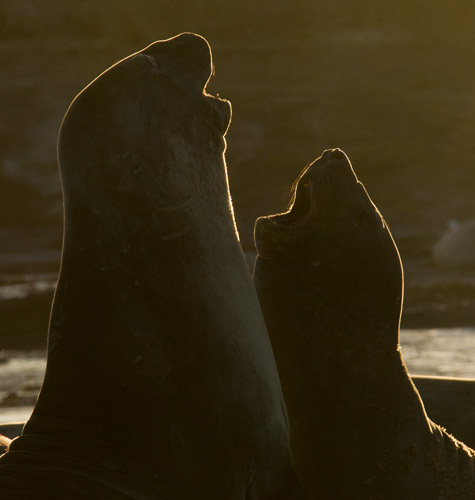
Day 12. Sea Lion Island
With hopes of finding the hunting Orcas at dawn, all of us were on the beach by 4:30 – still too late for first light as we near their summer solstice. In the orange-mauve colored seas of dawn I spotted the Orcas, silhouetted against this color, but they moved off before any of us had a chance for shots.
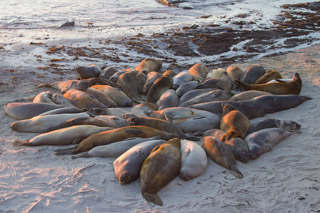 We spent the first two hours of this morning photographing Elephant Seals, including a most unusual behavior or pose I’d never seen or heard of. In the dawn hours perhaps 40-50 Elephant Seals were clustered in a circle-like formation, some of the seals with their head facing inwards, some with the backend, but either way, reminding me of Muskox in a defensive formation. These seals were obviously not in a defensive pose, and although it appeared to be a cluster to conserve heat, that doesn’t make sense, either, as the air conducts heat far more poorly than does water – and the seals are in that frigid water often. Nonetheless, the pose was incredible and we shot a lot of angles.
We spent the first two hours of this morning photographing Elephant Seals, including a most unusual behavior or pose I’d never seen or heard of. In the dawn hours perhaps 40-50 Elephant Seals were clustered in a circle-like formation, some of the seals with their head facing inwards, some with the backend, but either way, reminding me of Muskox in a defensive formation. These seals were obviously not in a defensive pose, and although it appeared to be a cluster to conserve heat, that doesn’t make sense, either, as the air conducts heat far more poorly than does water – and the seals are in that frigid water often. Nonetheless, the pose was incredible and we shot a lot of angles.
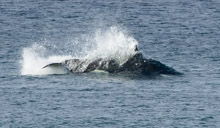
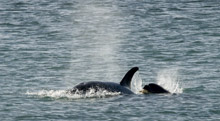
Orca chasing a penguin or seal -- it missed; Mother Orca and calf approaching
Eventually we headed to the Orca lookout area where we waited, and hoped, that Orcas would swim into the channel at high tide to hunt for seals. While we waited I missed the video sequence of the trip: a subadult Elephant Seal was sleeping on a ledge and decided to roll. It looked like it might topple off but, stupidly, I just sat and watched, and the Seal rolled, right off the ledge! It tumbled down, doing two or three rolls, but seemed to be unhurt (but perhaps embarrassed) as it landed and eventually humped his way back into the sea.
We were ready to leave for breakfast (8AM), leaving at 7:40 when Don spotted a fin – close to shore! We were already packed up and as we scrambled to get our gear we missed the best shot, when one Orca entered the channel and presented a front-on view. The Orcas coursed up and down the kelp beds for a few minutes, finally swimming around a bend and disappearing, and we still made our 8AM breakfast.
High Tide would crest around 9, and we headed back out to wait for Orcas and about 10AM the pod reappeared, swimming by the channel and kelp but not entering or hunting. Afterwards, Mary and I bushwhacked through the tussock Grass to cut distance in this ‘shortcut’, negotiating through these enormous grass clumps that create a challenging and exhausting maze. When we finally emerged 40 minutes later we were right at our target – a small pond where we photographed Flying Steamer Ducks, Yellow-billed Pintails, and Chloe Widgeons.
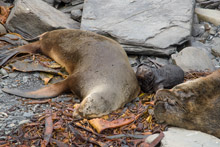
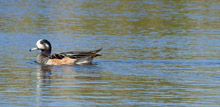
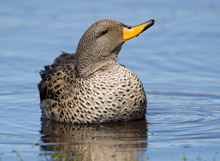
Southern Sealion and baby, Chloe Wigeon, Yellow-billed Pintail
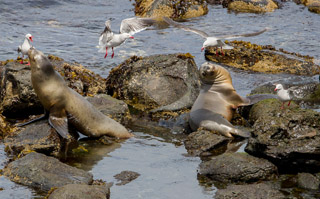
We continued on to the Sealion overlook where harem masters have staked out their territory in preparation for the arrival of the cows. One female already had a pup, and was attended to by one of these monstrous males that dwarf the Antarctic Fur Seals we dealt with less than a month ago in South Georgia. While we watched, a pair of Striated Caracaras flew in and cached meat under rocks and in the tussock – a bird of prey behavior I hadn’t seen before.
By 4 we were back at the lodge, exhausted from a long day. Clouds gathered, and we were not tempted to photograph post-dinner time, but by 8:30PM it was pouring rain. Don and Brenda did Long Pond, and had great luck with Silvery Grebes, the elusive Pipet, and Dotterals, birds I’ve not shot. Dick and Eric did the Gentoo Beach, and Ann had good luck at Long Pond with various birds as well.
Mary and I, at one point during our Sealion watch, took naps, and I got bit up in several places by penguin fleas!
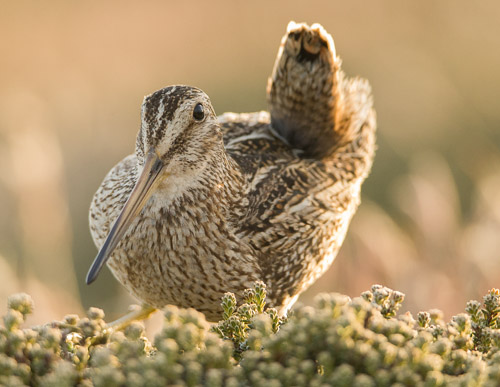
Falkland Snipe
Day 13. Sea Lion Island
We were exhausted yesterday, and with a misleading tide schedule and weather report we planned on sleeping in and getting to breakfast at 8. Don, however, always shoots sunrise and headed to the Elephant Seal beach where he found the Orcas were INSIDE THE CHANNEL! Don did not bring his 600mm and had to return to the lodge, where he graciously woke us up and we raced to the location. I didn’t have much hope – the Orcas usually come and vanish, but this time they remained until 8AM, going into the channel, exiting, circling about, and – the big female – returning to hunt. Her method – cruise along, taking a breath every ten seconds or so, then apparently getting a deep breath and heading into the channel – never surfacing and sometimes only with the tip of her dorsal fin visible. Elephant Seals of various sizes played or swam about in the shallows, but must have always been just out of reach. Later, when the pod cruised by the final time, a Sealion swam slowly about in the channel – perfect for an ambush, but the Orcas were gone.
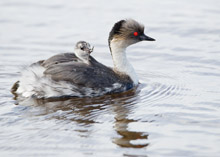
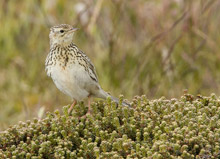
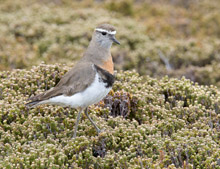
Silver Grebe with a chick on her back; Falkland Pipet; Rufous-chested Dotterel
After breakfast all of us got lifts to various locations. Inspired by Don and Brenda’s luck I was dropped off at Long Pond, where I hoped to photograph Silver Grebes with chicks on their backs. I was successful. Eric, Brenda, Ann, and Don had planned on doing the Sealions, but they were not inspiring and instead Eric and Brenda and Don returned to the pond. All of us had luck with a family of Grass Wrens, and again, inspired by D and B I searched for and found Rufous-chested Dotterel and the Pipet – both birds I’d never photographed before.
Storms raged around us, with lightning, and with the threat of a drenching everyone returned to the lodge before lunch. By 1 the skies were brilliantly clear and several of us headed to the Gentoo beach where, finally, we had incredible luck and shooting with hundreds of birds returning from the sea.
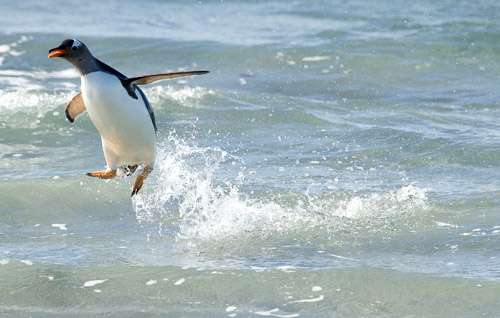
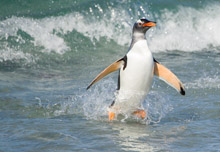
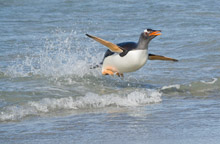
After dinner, Dick performed a moving, short ceremony as he dumped his brother’s ashes in the sea, and we spent the last hours – until 9PM or so – photographing Elephant Seals and Penguins, either as silhouettes or against the golden sands. Today was Dec. 21, the longest day of the year down here, and it was a long, and very productive one for us. Coincidentally, on June 21st, the northern hemisphere’s longest day, we were in Svalbard, for an equally long day high above the arctic circle – where the sun never set!
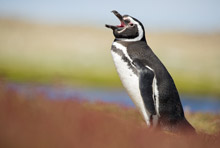
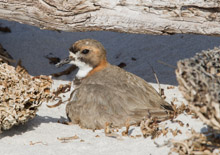
Magellanic Penguin; Two-banded Plover
With that our trip ended. The following day we headed back to Stanley where we had a relaxing afternoon, and from there, the following day, we flew on to Chile. We overnighted in Punta Arenas, as we were too late to make any Santiago to US connection, and had a great final dinner where we could review the many trip highlights, favorite places, favorite photo subjects, and our favorite photos. It was a great way to wrap up a tremendous trip.
We will be returning to the Falklands in December 2019 and January 2020. The December trip's subjects and experiences should be similar to this year's trip, and for an idea of the January opportunites check out the 2016 trip report.
For further details, check out our brochure -- it is not updated as of 1-29-2018 but between the three resources you should have a great idea as to what to expect. Truly this is one of our favorite shoots -- the opportunities are incredible.
Check out the latest video:
The Ultimate Antarctica video is now available!
Jaguars and the Wildlife of the Pantanal Photo Tour
How-to Video on Photographing Bats
Svalbard Video
Check out our other Falkland Island Trip Reports -
Join us on Facebook at: Follow Hoot Hollow
Office Phone: (717) 543-6423
Or FAX us at: (717) 543-5342
Mary and Joe are proud to endorse the Photo Retailer that has
done the absolute most in supporting nature photography in all
its facets ---

Check out the Monthly Specials
from Hunt's

Trip Report: Falklands 2017
We were lucky enough to visit the Falklands twice in 2017. Our first trip was a fairly short one, as we visited Saunders, Carcass, and New Island when we were on the Joseph Van Os Ultimate Antarctica trip. Our zodiac landings were fun, and too brief for us, and we were anxious to return about a month later when we hosted our Falklands Bird and Wildlife Photo Tour. For Falklands-based trips we stay on land, at the various guest homes, rather than on a ship. Often our group of eight were the only people at a location, and even at Sea Lion Island, where there is a larger lodge, there were fewer than 15 tourists, including us.
 The advantage of a land-based trip is you can always be photographing, regardless of the weather. In bad winds or bad seas, when zodiacs can't land, land-based photographers can still shoot. Travel from one island to another is by plane, FIGAS, the Falkland Island Government Air Service, and in the very, very rare times when FIGAS can't fly it doesn't matter -- you're already on an island so you just stay there, and continue photographing!
The advantage of a land-based trip is you can always be photographing, regardless of the weather. In bad winds or bad seas, when zodiacs can't land, land-based photographers can still shoot. Travel from one island to another is by plane, FIGAS, the Falkland Island Government Air Service, and in the very, very rare times when FIGAS can't fly it doesn't matter -- you're already on an island so you just stay there, and continue photographing!
We had a great group and, over-all, very good weather. The Falklands' Spring was a cold and wet one, but the weather changed by the time we arrived and our shooting, for the most part, was quite clement. We had one day with very powerful winds, but they could be avoided by just working some of the cliff-side colonies instead of the flats that were exposed to the wind.
Unlike past trips here, this time I did far more video than I did shooting stills. The video was fun (I used a Really Right Stuff video head) and captured scenes with more impact than a photo could, but the culling of images afterward was an enormous workload. Still, I hope to make several promo videos showcasing what you can expect on a Falklands trip.
Here's the report!
Day 1. Stanley, Falkland Islands
Everyone arrived in Punta Arenas after some major setbacks, which included one couple, Don and Brenda, having their luggage stuck in Miami as they flew down a day early – to avoid problems! Another participant, Eric, had his flight delayed in Washington, DC, and thus missed his connection to Santiago, Chile. Eric had to spend the night in Miami, but his luggage arrived, and Don and Judy’s luggage reached Punta Arenas with Eric. He picked it up and joined Don, who waited outside the luggage area with a taxi driver I had located who spoke English, and who was to help them get inside and explain the lost luggage/and recovery if Eric didn’t. With that, all our problems were over the day before we flew to Stanley, the capital of the Falklands. We arrived in late afternoon to a sunny sky and pleasant temperatures, a nice contrast to the preceding weeks of reportedly miserable Falklands’ weather. After an early dinner, everyone organized for our first field outing, tomorrow, to Volunteer Point.
Day 2. Volunteer Point
 We left our hotel at 7:30AM for the 2-3 hour drive to Volunteer Point, the site of the largest King Penguin colony in the Falklands. I’ve been traveling here for the last twenty years off and on, and the contrast in the road and driving conditions now, compared to the cross-country struggle we did in our first few years, made this trip relatively pleasant. There were still bog holes to avoid, and innumerable bumpy roads, but the days of jacking up vehicles, using metal planks to ford swamps, and climbing steep hillsides are over.
We left our hotel at 7:30AM for the 2-3 hour drive to Volunteer Point, the site of the largest King Penguin colony in the Falklands. I’ve been traveling here for the last twenty years off and on, and the contrast in the road and driving conditions now, compared to the cross-country struggle we did in our first few years, made this trip relatively pleasant. There were still bog holes to avoid, and innumerable bumpy roads, but the days of jacking up vehicles, using metal planks to ford swamps, and climbing steep hillsides are over.
Although we had intended on devoting all of our time to the King Penguins, the Gentoo Penguins nesting nearby had newly hatched, tiny and cute chicks, and these diverted our attention. Most birds were still on eggs, but a few had chicks that were large enough to barely fit beneath their brooding parent. Several, however, had virtually new hatchlings, complete with egg-teeth that the hatchlings use to slice an escape hatch from the egg. Gentoos lay two eggs, a few days apart, to insure that one of thehatchling survives, and if there is enough food, so, too, will the other. Right now, conditions seemed so favorable that both chicks looked of equal size, and healthy.
 King Penguins were either incubating, or still waiting to lay their single egg. Mary almost videoed an egg-transfer, as these Penguins incubate their egg (and very young chicks) as the eggs rests upon the adults feet. At transfer, an egg is carefully passed from one bird’s feet to the other, without the egg touching the ground, or doing so only for a moment. Dick, who remained with a pair who appeared ready to do the transfer, saw this, although the birds turned away at the critical moment,
King Penguins were either incubating, or still waiting to lay their single egg. Mary almost videoed an egg-transfer, as these Penguins incubate their egg (and very young chicks) as the eggs rests upon the adults feet. At transfer, an egg is carefully passed from one bird’s feet to the other, without the egg touching the ground, or doing so only for a moment. Dick, who remained with a pair who appeared ready to do the transfer, saw this, although the birds turned away at the critical moment,
Kings have a three year cycle, as their single chick takes over one year to mature. Eggs laid now, in December, would hatch in January and the chick will be fed throughout the remainder of the summer and fall. In winter, adults return to sea  and only occasionally visit the colony to feed their chicks, who creche up to keep warm and to survive. By the following summer those that survive are molting and are ready to head to the water. We filmed these, some with shaggy brown coats that completely covered the chick in a woolly-looking coat, while others had wispy beards that barely concealed the adult plumage emerging from beneath.
and only occasionally visit the colony to feed their chicks, who creche up to keep warm and to survive. By the following summer those that survive are molting and are ready to head to the water. We filmed these, some with shaggy brown coats that completely covered the chick in a woolly-looking coat, while others had wispy beards that barely concealed the adult plumage emerging from beneath.
Mary, Don, and Brenda made it down to the sandy beach, an emerald-colored bay that seems more appropriate for the tropics than the temperate subarctic. Birds strolled the white sands, and a few bathed or played in the surf. At 2PM we were scheduled to head back to town, and fortunately the skies had begun to cloud cover and the temperature to drop. The best shooting was over.
On our return to town we stopped to photograph the unique Stone Runs, a river of rocks that are the relic traces of glacial movement. The exact origin, or explanation, for the Runs is still somewhat unclear, but the rocks may have slid down glacial ice and melted through, but from the area these streams do indeed look like rivers … but of rocks. We reached our lodge by 5:30PM, under a light overcast.
Day 3. The Cape


Macaroni Penguin; King Cormorant
We left at 7:30 for the nearly three hour drive to the Cape where we hoped to find Macaroni Penguins, as well as the expected Rockhoppers and King Cormorants. When we arrived I did a quick survey at one colony where I apparently missed two, as Ann later discovered two Macronis, one with a fairly good size chick and one brooding an egg. In total, we had 10 Macaronis, a promising increase from two years ago.

 Southern Sealions were hauled out on the grassy hilltop, but I was too involved with the birds and missed any shots. Rockhoppers had tiny chicks, and the birds were quite close and unconcerned. King Cormorants had several colonies, and Mary spotted some tiny ‘snake babies,’ the skinny-necked chicks, but I only saw eggs. Using a wide-angle and lying along a pathway, Idid some wonderful video and stills as birds paraded by, many carrying grassy clumps, moss, or strands of kelp.
Southern Sealions were hauled out on the grassy hilltop, but I was too involved with the birds and missed any shots. Rockhoppers had tiny chicks, and the birds were quite close and unconcerned. King Cormorants had several colonies, and Mary spotted some tiny ‘snake babies,’ the skinny-necked chicks, but I only saw eggs. Using a wide-angle and lying along a pathway, Idid some wonderful video and stills as birds paraded by, many carrying grassy clumps, moss, or strands of kelp.
We were scheduled to leave at 2, but the shooting was too good and we paid for an extra hour, which was all we needed to complete an incredible day.
Day 4. Carcass



Black-crowned Night Heron; Black-throated Finch; Cobb's Wren
We were lucky enough to get the first FIGAS flight to Carcass, with all of us in one plane, and with our luggage arriving in mid-afternoon. The tide was falling as we arrived, although by very late afternoon the tide had rolled back in to the end of the beach. We found three different Oystercatcher nests, two Blackish and one Pied. Mary and Ann had a great shoot with a Falkland Snipe, that bathed in a small pool. At one point, a Magellanic Penguin walked passed one of the Black Oystercatcher nests and both birds attacked, poking and squawking , and driving the bird away. Eric had found a roosting/sleeping group of Pied Oystercatchers, and when I arrived there were 21 birds sleeping on the beach. They were completely unconcerned, only piping alarms when Striated Caracaras sailed by.
Steamer ducks had chicks, quite small but nonetheless diving underwater at times; a lone white chick of a Kelp Goose followed the hen constantly; Black-crowned Night Herons nested, and my highlight was a Heron that was virtually oblivious to me, and eventually caught a good-sized fish. We had the complete contingent of birds here – Kelp and Upland Geese, Crested Ducks and Steamer Ducks, Dolphin Gulls, Striated Caracaras, Black-throated Finches, Long-tailed Meadowlarks, Falkland Thrushes … a spectacular day.
The afternoon/evening concluded for us when Mary and I treated Don’s torn ear, as he slipped on a rock and his tripod ripped a good hunk of flesh from the ear. After dinner, Don headed back out for some low-light scenic shots.

Day 5. Carcass and West Point
Before breakfast I scouted out a spot where I’d seen the tiny Grass Wren in the past, and I was lucky enough to find an adult feeding two hidden but fledged chicks, at 7:55, minutes before breakfast. Afterwards we boarded the new Catamaran boat for the hour trip to West Point for a nice colony of Black-browed Albatross and Rockhopper Penguins. I was pleasantly surprised to be greeted by a very old friend, Allen White, who was my cabin mate on my very first Antarctica trip where the two of us guided. Allen went on to guide for Zeaghrams Expeditions for 10 years, traveling the world, but his career guiding was cut short when the zodiac, stern loaded, was swept beneath the landing area as the sea receded, trapping Allen’s leg between zodiac and ship when the sea rose. It was a bad break.
Allen and our boat crew drove us up to the rookery where we spent the next six hours. I spent a long time at a small colony while Mary and the rest of the group  was at another, where they spotted several eggs that were in the process of hatching. One egg had hatched completely, with a wet chick beneath the adult, while the other eggs were in frustrating, tantalizing stages of hatching, with either open holes or half-opened shells, with the chick still inside. This was the first time we’ve been in the Falklands during hatching, and although Mary spent nearly the entire day waiting, the process, apparently, is a slow one that cannot be rushed!
was at another, where they spotted several eggs that were in the process of hatching. One egg had hatched completely, with a wet chick beneath the adult, while the other eggs were in frustrating, tantalizing stages of hatching, with either open holes or half-opened shells, with the chick still inside. This was the first time we’ve been in the Falklands during hatching, and although Mary spent nearly the entire day waiting, the process, apparently, is a slow one that cannot be rushed!
By late afternoon a heavy fog rolled in, wetting us down and dropping the light. At 4 we headed back to the ship for a cruise searching for dolphins, but none showed, and we arrived at the lodge around 6PM.
Day 6. Carcass
 This was one of those absolutely great days prompting me to consider the Falklands as one of my absolute favorite destinations. Some of the group left after breakfast for a drive across the island for Elephant Seals. They enjoyed the morning, getting one young pair of males fighting in the surf.
This was one of those absolutely great days prompting me to consider the Falklands as one of my absolute favorite destinations. Some of the group left after breakfast for a drive across the island for Elephant Seals. They enjoyed the morning, getting one young pair of males fighting in the surf.
Meanwhile, prior to breakfast, I again found the Grass Wren and had even better shooting. Afterwards, Ann and I moved slowly up the beach where we photographed both Oystercatchers, ducks and geese, and, to our surprise, two weaner Elephant Seals. On the way back Ann spooked a Blackish Oystercatcher off the nest, with chicks, but without any harm, and later that afternoon …. I’ll get to that great shoot soon. I found a Falklands Snipe, flushed out by a family of Upland Geese, and the morning rushed by.
 After lunch I tried for my nemesis bird, the Long-tailed Meadowlark. While waiting, out of the wind and warm, I stretched out an slept for an hour, and when I awoke the Grass Wrens had moved up the gully to my present position. For the next 45 minutes I staked out a spot where the two fledglings were hiding and where the adults visited, and got my best shots, ever. As I headed out to check the beach I got my best – for now at least – Meadowlark shots.
After lunch I tried for my nemesis bird, the Long-tailed Meadowlark. While waiting, out of the wind and warm, I stretched out an slept for an hour, and when I awoke the Grass Wrens had moved up the gully to my present position. For the next 45 minutes I staked out a spot where the two fledglings were hiding and where the adults visited, and got my best shots, ever. As I headed out to check the beach I got my best – for now at least – Meadowlark shots.
I was alone and moving at my own, very slow pace, and spent time with a Pied Oystercatcher I hoped would turn her eggs (she didn’t). Moving on, I found the Blackish Oystercatcher with the chicks, and soon after I settled on this Ann joined me. Oddly, alarm calls (piping calls) from Pied Oystercatchers would set these birds on alert, and several times they flew off, circling, before returning. As they returned, birds would walk right by me … and with me sitting low and still, I knew I was accepted.

As the afternoon continued I moved a bit closer, getting better views and shots of the two chicks, while the adults did a nest exchange and eventually settled, sleeping, only feet away from me. When I slowly backed off, finished shooting, the  birds didn’t move. A family of Kelp Geese were nearby and also accepted me, giving me frame-filling shots of the chicks and the hen with her brood. The intimacy of these encounters was just spectacular, and as I slowly passed oblivious birds on my way home I conclude that the Falklands has to be one of my all-time favorite locations, anywhere. The wildlife is at tame as the Galapagos, but the freedom one has here, to spend all day with one subject if one wishes, cannot be duplicated.
birds didn’t move. A family of Kelp Geese were nearby and also accepted me, giving me frame-filling shots of the chicks and the hen with her brood. The intimacy of these encounters was just spectacular, and as I slowly passed oblivious birds on my way home I conclude that the Falklands has to be one of my all-time favorite locations, anywhere. The wildlife is at tame as the Galapagos, but the freedom one has here, to spend all day with one subject if one wishes, cannot be duplicated.


Falkland Thrush; Pied Oystercatcher
Day 7. Carcass to Saunders
 We had another early flight, a ten minute commute from one island to another, which we did in two back-to-back flights. We traveled by landrover to the Neck, had a quick lunch, and in increasingly brooding skies we headed to the Rockhopper and Albatross colonies on the ridge. Rockhoppers were a bit further along than at the Cape, with some birds nearly half the size of the adults. The colony, because of a nest failure two years ago and increasing predation last year and this, is now 25% the size it was four years ago! The Striated Caracaras are a major threat, and if their predation continues it is quite likely that the colony will be wiped out in a few years.
We had another early flight, a ten minute commute from one island to another, which we did in two back-to-back flights. We traveled by landrover to the Neck, had a quick lunch, and in increasingly brooding skies we headed to the Rockhopper and Albatross colonies on the ridge. Rockhoppers were a bit further along than at the Cape, with some birds nearly half the size of the adults. The colony, because of a nest failure two years ago and increasing predation last year and this, is now 25% the size it was four years ago! The Striated Caracaras are a major threat, and if their predation continues it is quite likely that the colony will be wiped out in a few years.
Albatrosses were flying everywhere, and I tried slow motion video – an incredible challenge, as the birds whip by quickly, rarely giving more than 2 or 3 seconds of opportunity. Most often, autofocus caught the background – the colony or the sea – and I missed some incredible opportunities as birds drifted in . Still, by only shooting video, I caught some sequences.
A lone Macaroni Penguin has paired with a Rockhopper, which our JVO trip had a month ago. By 5PM Rockhoppers were coming back in, smashed against the rocks, bouncing off, and eventually gaining access and climbing ashore. A Southern Sealion swam by, body surfing the waves in quite obvious play. By 6:30 the light dropped and it began to rain and we headed to camp.

Day 8. Saunders at the Neck
Don headed out at 4:30AM for a sunrise, although the rest of us before bad weather settled in for a part of the morning. By 9:45 or so the rain had stopped and everyone headed out to various locations – some to the rookeries on the hill top, others to the beach, and, for me, to the Rockhoppers to check if or when birds returned earlier than the late evening. Although the shooting was a bit sporadic, birds did arrive throughout the morning.



Rockhopper surfing in; Commerson's Dolphin in a curl; Rockhopper
After lunch a storm front moved through, bringing with it some rain and higher winds, but I’d moved out to a distant spot overlooking one of the Rockhopper haul outs where I had found an overhanging ledge. There, I was blocked from both the wind and rain, and when the sun finally shone it was actually quite warm. Most of the rest of the group went to a nearby haul out, where I joined them to help some folks across the rocks, and the shooting was fair – not as good as the evening before. Most worrisome were the high rollers crashing in with the rising tide, and I worried that a sneaker wave might catch us by surprise. None did, but by 6PM the seas threatened to cut off our exit and most folks headed back to camp. I climbed the cliff to visit the Rockhoppers a final time, where I found several Black-browed Albatrosses that joined me on a ledge over-looking the colony. Birds strode up to me as if I were just another bird, and I did some pleasant wide-angle shots of adults with the colony in the background. By 7 clouds cut off the sun and the shooting was over.
Day 9. Saunders and the Settlement
Heavy winds and pounding rain woke us several times during the night but the day dawned clear, a misleading forecast as repeated squalls forced us back inside. Don was caught out in the first one and was soaked, although in the settlement hail had carpeted windowsills with an inch of ice.
 Between squalls most of us photographed Gentoo Penguins, and watched as Skuas stole chicks and Caracaras charged in to the colony, attempting to spook adults from their nest. We were scheduled to visit the other rookery this afternoon but with the threat of more squalls, and marooned there without a vehicle for shelter, we decided to remain at the settlement where, in late afternoon, we photographed Giant Petrels scavenging sheep bones.
Between squalls most of us photographed Gentoo Penguins, and watched as Skuas stole chicks and Caracaras charged in to the colony, attempting to spook adults from their nest. We were scheduled to visit the other rookery this afternoon but with the threat of more squalls, and marooned there without a vehicle for shelter, we decided to remain at the settlement where, in late afternoon, we photographed Giant Petrels scavenging sheep bones.
Day 10. Saunders Rookery

Rockhopper Penguin at 'the shower'
After breakfast we headed to another Rockhopper and Albatross colony, called ‘the rookery, which is the location for a unique feature, The Shower, where Rockhoppers literally shower beneath a small cascading trickle. We had a tremendous and debilitating wind today, but beneath the ridge, where the Albatross nest and where the Rockhoppers shower, and climb uphill, the weather was quite pleasant. Mary checked out the shower early, and reported that it was in shade, so I decided to do video then, since fast shutter speeds would not be a problem.
As it turned out, that was a good move, and everyone eventually came down to shoot the birds in the shade of the ledges. By 2PM or so the shower would be in sunlight, but because of the tiresome wind we decided to be picked up at 3PM, giving us time for another crack at the Giant Petrels.
Yesterday’s Petrels were eating small scraps, giving us plenty of chase scenes when one bird would grab a morsel, and then be pursued by a mob. Today, piles of just-slaughtered sheep guts were dumped into the sea, creating mob scenes of fighting birds but fewer chases. Nonetheless, Mary (who didn’t shoot yesterday’s birds) shot 94gb!

Day 11. Saunders to Sea Lion Island
 FIGAS, the Falkland Island Government Air Service, was down to just one plane for all their transfers today, and Mary and I were originally scheduled to do a late afternoon flight. Before bedtime last night we were told of a change – we were now leaving at 9, with the rest of the group flying out at 2. This gave us plenty of time to check out some areas, including a lookout point for the Orcas that are now patrolling, looking for seals.
FIGAS, the Falkland Island Government Air Service, was down to just one plane for all their transfers today, and Mary and I were originally scheduled to do a late afternoon flight. Before bedtime last night we were told of a change – we were now leaving at 9, with the rest of the group flying out at 2. This gave us plenty of time to check out some areas, including a lookout point for the Orcas that are now patrolling, looking for seals.
The group arrived by 3 and everyone had plenty of time to shoot a wide variety of subjects. After dinner, hoping for the Orcas, we headed to the beach where over 100 Elephant Seals are hauled out and, at sunset, wrestle, tussle, and fight. Mary and Don did some great backlighted Penguins against a golden sand washed by the setting sun, while I worked on videos of the seals.

Day 12. Sea Lion Island
With hopes of finding the hunting Orcas at dawn, all of us were on the beach by 4:30 – still too late for first light as we near their summer solstice. In the orange-mauve colored seas of dawn I spotted the Orcas, silhouetted against this color, but they moved off before any of us had a chance for shots.
 We spent the first two hours of this morning photographing Elephant Seals, including a most unusual behavior or pose I’d never seen or heard of. In the dawn hours perhaps 40-50 Elephant Seals were clustered in a circle-like formation, some of the seals with their head facing inwards, some with the backend, but either way, reminding me of Muskox in a defensive formation. These seals were obviously not in a defensive pose, and although it appeared to be a cluster to conserve heat, that doesn’t make sense, either, as the air conducts heat far more poorly than does water – and the seals are in that frigid water often. Nonetheless, the pose was incredible and we shot a lot of angles.
We spent the first two hours of this morning photographing Elephant Seals, including a most unusual behavior or pose I’d never seen or heard of. In the dawn hours perhaps 40-50 Elephant Seals were clustered in a circle-like formation, some of the seals with their head facing inwards, some with the backend, but either way, reminding me of Muskox in a defensive formation. These seals were obviously not in a defensive pose, and although it appeared to be a cluster to conserve heat, that doesn’t make sense, either, as the air conducts heat far more poorly than does water – and the seals are in that frigid water often. Nonetheless, the pose was incredible and we shot a lot of angles.


Orca chasing a penguin or seal -- it missed; Mother Orca and calf approaching
Eventually we headed to the Orca lookout area where we waited, and hoped, that Orcas would swim into the channel at high tide to hunt for seals. While we waited I missed the video sequence of the trip: a subadult Elephant Seal was sleeping on a ledge and decided to roll. It looked like it might topple off but, stupidly, I just sat and watched, and the Seal rolled, right off the ledge! It tumbled down, doing two or three rolls, but seemed to be unhurt (but perhaps embarrassed) as it landed and eventually humped his way back into the sea.
We were ready to leave for breakfast (8AM), leaving at 7:40 when Don spotted a fin – close to shore! We were already packed up and as we scrambled to get our gear we missed the best shot, when one Orca entered the channel and presented a front-on view. The Orcas coursed up and down the kelp beds for a few minutes, finally swimming around a bend and disappearing, and we still made our 8AM breakfast.
High Tide would crest around 9, and we headed back out to wait for Orcas and about 10AM the pod reappeared, swimming by the channel and kelp but not entering or hunting. Afterwards, Mary and I bushwhacked through the tussock Grass to cut distance in this ‘shortcut’, negotiating through these enormous grass clumps that create a challenging and exhausting maze. When we finally emerged 40 minutes later we were right at our target – a small pond where we photographed Flying Steamer Ducks, Yellow-billed Pintails, and Chloe Widgeons.



Southern Sealion and baby, Chloe Wigeon, Yellow-billed Pintail

We continued on to the Sealion overlook where harem masters have staked out their territory in preparation for the arrival of the cows. One female already had a pup, and was attended to by one of these monstrous males that dwarf the Antarctic Fur Seals we dealt with less than a month ago in South Georgia. While we watched, a pair of Striated Caracaras flew in and cached meat under rocks and in the tussock – a bird of prey behavior I hadn’t seen before.
By 4 we were back at the lodge, exhausted from a long day. Clouds gathered, and we were not tempted to photograph post-dinner time, but by 8:30PM it was pouring rain. Don and Brenda did Long Pond, and had great luck with Silvery Grebes, the elusive Pipet, and Dotterals, birds I’ve not shot. Dick and Eric did the Gentoo Beach, and Ann had good luck at Long Pond with various birds as well.
Mary and I, at one point during our Sealion watch, took naps, and I got bit up in several places by penguin fleas!

Falkland Snipe
Day 13. Sea Lion Island
We were exhausted yesterday, and with a misleading tide schedule and weather report we planned on sleeping in and getting to breakfast at 8. Don, however, always shoots sunrise and headed to the Elephant Seal beach where he found the Orcas were INSIDE THE CHANNEL! Don did not bring his 600mm and had to return to the lodge, where he graciously woke us up and we raced to the location. I didn’t have much hope – the Orcas usually come and vanish, but this time they remained until 8AM, going into the channel, exiting, circling about, and – the big female – returning to hunt. Her method – cruise along, taking a breath every ten seconds or so, then apparently getting a deep breath and heading into the channel – never surfacing and sometimes only with the tip of her dorsal fin visible. Elephant Seals of various sizes played or swam about in the shallows, but must have always been just out of reach. Later, when the pod cruised by the final time, a Sealion swam slowly about in the channel – perfect for an ambush, but the Orcas were gone.



Silver Grebe with a chick on her back; Falkland Pipet; Rufous-chested Dotterel
After breakfast all of us got lifts to various locations. Inspired by Don and Brenda’s luck I was dropped off at Long Pond, where I hoped to photograph Silver Grebes with chicks on their backs. I was successful. Eric, Brenda, Ann, and Don had planned on doing the Sealions, but they were not inspiring and instead Eric and Brenda and Don returned to the pond. All of us had luck with a family of Grass Wrens, and again, inspired by D and B I searched for and found Rufous-chested Dotterel and the Pipet – both birds I’d never photographed before.
Storms raged around us, with lightning, and with the threat of a drenching everyone returned to the lodge before lunch. By 1 the skies were brilliantly clear and several of us headed to the Gentoo beach where, finally, we had incredible luck and shooting with hundreds of birds returning from the sea.



After dinner, Dick performed a moving, short ceremony as he dumped his brother’s ashes in the sea, and we spent the last hours – until 9PM or so – photographing Elephant Seals and Penguins, either as silhouettes or against the golden sands. Today was Dec. 21, the longest day of the year down here, and it was a long, and very productive one for us. Coincidentally, on June 21st, the northern hemisphere’s longest day, we were in Svalbard, for an equally long day high above the arctic circle – where the sun never set!


Magellanic Penguin; Two-banded Plover
With that our trip ended. The following day we headed back to Stanley where we had a relaxing afternoon, and from there, the following day, we flew on to Chile. We overnighted in Punta Arenas, as we were too late to make any Santiago to US connection, and had a great final dinner where we could review the many trip highlights, favorite places, favorite photo subjects, and our favorite photos. It was a great way to wrap up a tremendous trip.
We will be returning to the Falklands in December 2019 and January 2020. The December trip's subjects and experiences should be similar to this year's trip, and for an idea of the January opportunites check out the 2016 trip report.
For further details, check out our brochure -- it is not updated as of 1-29-2018 but between the three resources you should have a great idea as to what to expect. Truly this is one of our favorite shoots -- the opportunities are incredible.
Check out the latest video:
The Ultimate Antarctica video is now available!
Jaguars and the Wildlife of the Pantanal Photo Tour
How-to Video on Photographing Bats
Svalbard Video
Check out our other Falkland Island Trip Reports -
Join us on Facebook at: Follow Hoot Hollow
Office Phone: (717) 543-6423
Or FAX us at: (717) 543-5342
Mary and Joe are proud to endorse the Photo Retailer that has
done the absolute most in supporting nature photography in all
its facets ---

Check out the Monthly Specials
from Hunt's

Trip Report: Falklands 2017
We were lucky enough to visit the Falklands twice in 2017. Our first trip was a fairly short one, as we visited Saunders, Carcass, and New Island when we were on the Joseph Van Os Ultimate Antarctica trip. Our zodiac landings were fun, and too brief for us, and we were anxious to return about a month later when we hosted our Falklands Bird and Wildlife Photo Tour. For Falklands-based trips we stay on land, at the various guest homes, rather than on a ship. Often our group of eight were the only people at a location, and even at Sea Lion Island, where there is a larger lodge, there were fewer than 15 tourists, including us.
 The advantage of a land-based trip is you can always be photographing, regardless of the weather. In bad winds or bad seas, when zodiacs can't land, land-based photographers can still shoot. Travel from one island to another is by plane, FIGAS, the Falkland Island Government Air Service, and in the very, very rare times when FIGAS can't fly it doesn't matter -- you're already on an island so you just stay there, and continue photographing!
The advantage of a land-based trip is you can always be photographing, regardless of the weather. In bad winds or bad seas, when zodiacs can't land, land-based photographers can still shoot. Travel from one island to another is by plane, FIGAS, the Falkland Island Government Air Service, and in the very, very rare times when FIGAS can't fly it doesn't matter -- you're already on an island so you just stay there, and continue photographing!
We had a great group and, over-all, very good weather. The Falklands' Spring was a cold and wet one, but the weather changed by the time we arrived and our shooting, for the most part, was quite clement. We had one day with very powerful winds, but they could be avoided by just working some of the cliff-side colonies instead of the flats that were exposed to the wind.
Unlike past trips here, this time I did far more video than I did shooting stills. The video was fun (I used a Really Right Stuff video head) and captured scenes with more impact than a photo could, but the culling of images afterward was an enormous workload. Still, I hope to make several promo videos showcasing what you can expect on a Falklands trip.
Here's the report!
Day 1. Stanley, Falkland Islands
Everyone arrived in Punta Arenas after some major setbacks, which included one couple, Don and Brenda, having their luggage stuck in Miami as they flew down a day early – to avoid problems! Another participant, Eric, had his flight delayed in Washington, DC, and thus missed his connection to Santiago, Chile. Eric had to spend the night in Miami, but his luggage arrived, and Don and Judy’s luggage reached Punta Arenas with Eric. He picked it up and joined Don, who waited outside the luggage area with a taxi driver I had located who spoke English, and who was to help them get inside and explain the lost luggage/and recovery if Eric didn’t. With that, all our problems were over the day before we flew to Stanley, the capital of the Falklands. We arrived in late afternoon to a sunny sky and pleasant temperatures, a nice contrast to the preceding weeks of reportedly miserable Falklands’ weather. After an early dinner, everyone organized for our first field outing, tomorrow, to Volunteer Point.
Day 2. Volunteer Point
 We left our hotel at 7:30AM for the 2-3 hour drive to Volunteer Point, the site of the largest King Penguin colony in the Falklands. I’ve been traveling here for the last twenty years off and on, and the contrast in the road and driving conditions now, compared to the cross-country struggle we did in our first few years, made this trip relatively pleasant. There were still bog holes to avoid, and innumerable bumpy roads, but the days of jacking up vehicles, using metal planks to ford swamps, and climbing steep hillsides are over.
We left our hotel at 7:30AM for the 2-3 hour drive to Volunteer Point, the site of the largest King Penguin colony in the Falklands. I’ve been traveling here for the last twenty years off and on, and the contrast in the road and driving conditions now, compared to the cross-country struggle we did in our first few years, made this trip relatively pleasant. There were still bog holes to avoid, and innumerable bumpy roads, but the days of jacking up vehicles, using metal planks to ford swamps, and climbing steep hillsides are over.
Although we had intended on devoting all of our time to the King Penguins, the Gentoo Penguins nesting nearby had newly hatched, tiny and cute chicks, and these diverted our attention. Most birds were still on eggs, but a few had chicks that were large enough to barely fit beneath their brooding parent. Several, however, had virtually new hatchlings, complete with egg-teeth that the hatchlings use to slice an escape hatch from the egg. Gentoos lay two eggs, a few days apart, to insure that one of thehatchling survives, and if there is enough food, so, too, will the other. Right now, conditions seemed so favorable that both chicks looked of equal size, and healthy.
 King Penguins were either incubating, or still waiting to lay their single egg. Mary almost videoed an egg-transfer, as these Penguins incubate their egg (and very young chicks) as the eggs rests upon the adults feet. At transfer, an egg is carefully passed from one bird’s feet to the other, without the egg touching the ground, or doing so only for a moment. Dick, who remained with a pair who appeared ready to do the transfer, saw this, although the birds turned away at the critical moment,
King Penguins were either incubating, or still waiting to lay their single egg. Mary almost videoed an egg-transfer, as these Penguins incubate their egg (and very young chicks) as the eggs rests upon the adults feet. At transfer, an egg is carefully passed from one bird’s feet to the other, without the egg touching the ground, or doing so only for a moment. Dick, who remained with a pair who appeared ready to do the transfer, saw this, although the birds turned away at the critical moment,
Kings have a three year cycle, as their single chick takes over one year to mature. Eggs laid now, in December, would hatch in January and the chick will be fed throughout the remainder of the summer and fall. In winter, adults return to sea  and only occasionally visit the colony to feed their chicks, who creche up to keep warm and to survive. By the following summer those that survive are molting and are ready to head to the water. We filmed these, some with shaggy brown coats that completely covered the chick in a woolly-looking coat, while others had wispy beards that barely concealed the adult plumage emerging from beneath.
and only occasionally visit the colony to feed their chicks, who creche up to keep warm and to survive. By the following summer those that survive are molting and are ready to head to the water. We filmed these, some with shaggy brown coats that completely covered the chick in a woolly-looking coat, while others had wispy beards that barely concealed the adult plumage emerging from beneath.
Mary, Don, and Brenda made it down to the sandy beach, an emerald-colored bay that seems more appropriate for the tropics than the temperate subarctic. Birds strolled the white sands, and a few bathed or played in the surf. At 2PM we were scheduled to head back to town, and fortunately the skies had begun to cloud cover and the temperature to drop. The best shooting was over.
On our return to town we stopped to photograph the unique Stone Runs, a river of rocks that are the relic traces of glacial movement. The exact origin, or explanation, for the Runs is still somewhat unclear, but the rocks may have slid down glacial ice and melted through, but from the area these streams do indeed look like rivers … but of rocks. We reached our lodge by 5:30PM, under a light overcast.
Day 3. The Cape


Macaroni Penguin; King Cormorant
We left at 7:30 for the nearly three hour drive to the Cape where we hoped to find Macaroni Penguins, as well as the expected Rockhoppers and King Cormorants. When we arrived I did a quick survey at one colony where I apparently missed two, as Ann later discovered two Macronis, one with a fairly good size chick and one brooding an egg. In total, we had 10 Macaronis, a promising increase from two years ago.

 Southern Sealions were hauled out on the grassy hilltop, but I was too involved with the birds and missed any shots. Rockhoppers had tiny chicks, and the birds were quite close and unconcerned. King Cormorants had several colonies, and Mary spotted some tiny ‘snake babies,’ the skinny-necked chicks, but I only saw eggs. Using a wide-angle and lying along a pathway, Idid some wonderful video and stills as birds paraded by, many carrying grassy clumps, moss, or strands of kelp.
Southern Sealions were hauled out on the grassy hilltop, but I was too involved with the birds and missed any shots. Rockhoppers had tiny chicks, and the birds were quite close and unconcerned. King Cormorants had several colonies, and Mary spotted some tiny ‘snake babies,’ the skinny-necked chicks, but I only saw eggs. Using a wide-angle and lying along a pathway, Idid some wonderful video and stills as birds paraded by, many carrying grassy clumps, moss, or strands of kelp.
We were scheduled to leave at 2, but the shooting was too good and we paid for an extra hour, which was all we needed to complete an incredible day.
Day 4. Carcass



Black-crowned Night Heron; Black-throated Finch; Cobb's Wren
We were lucky enough to get the first FIGAS flight to Carcass, with all of us in one plane, and with our luggage arriving in mid-afternoon. The tide was falling as we arrived, although by very late afternoon the tide had rolled back in to the end of the beach. We found three different Oystercatcher nests, two Blackish and one Pied. Mary and Ann had a great shoot with a Falkland Snipe, that bathed in a small pool. At one point, a Magellanic Penguin walked passed one of the Black Oystercatcher nests and both birds attacked, poking and squawking , and driving the bird away. Eric had found a roosting/sleeping group of Pied Oystercatchers, and when I arrived there were 21 birds sleeping on the beach. They were completely unconcerned, only piping alarms when Striated Caracaras sailed by.
Steamer ducks had chicks, quite small but nonetheless diving underwater at times; a lone white chick of a Kelp Goose followed the hen constantly; Black-crowned Night Herons nested, and my highlight was a Heron that was virtually oblivious to me, and eventually caught a good-sized fish. We had the complete contingent of birds here – Kelp and Upland Geese, Crested Ducks and Steamer Ducks, Dolphin Gulls, Striated Caracaras, Black-throated Finches, Long-tailed Meadowlarks, Falkland Thrushes … a spectacular day.
The afternoon/evening concluded for us when Mary and I treated Don’s torn ear, as he slipped on a rock and his tripod ripped a good hunk of flesh from the ear. After dinner, Don headed back out for some low-light scenic shots.

Day 5. Carcass and West Point
Before breakfast I scouted out a spot where I’d seen the tiny Grass Wren in the past, and I was lucky enough to find an adult feeding two hidden but fledged chicks, at 7:55, minutes before breakfast. Afterwards we boarded the new Catamaran boat for the hour trip to West Point for a nice colony of Black-browed Albatross and Rockhopper Penguins. I was pleasantly surprised to be greeted by a very old friend, Allen White, who was my cabin mate on my very first Antarctica trip where the two of us guided. Allen went on to guide for Zeaghrams Expeditions for 10 years, traveling the world, but his career guiding was cut short when the zodiac, stern loaded, was swept beneath the landing area as the sea receded, trapping Allen’s leg between zodiac and ship when the sea rose. It was a bad break.
Allen and our boat crew drove us up to the rookery where we spent the next six hours. I spent a long time at a small colony while Mary and the rest of the group  was at another, where they spotted several eggs that were in the process of hatching. One egg had hatched completely, with a wet chick beneath the adult, while the other eggs were in frustrating, tantalizing stages of hatching, with either open holes or half-opened shells, with the chick still inside. This was the first time we’ve been in the Falklands during hatching, and although Mary spent nearly the entire day waiting, the process, apparently, is a slow one that cannot be rushed!
was at another, where they spotted several eggs that were in the process of hatching. One egg had hatched completely, with a wet chick beneath the adult, while the other eggs were in frustrating, tantalizing stages of hatching, with either open holes or half-opened shells, with the chick still inside. This was the first time we’ve been in the Falklands during hatching, and although Mary spent nearly the entire day waiting, the process, apparently, is a slow one that cannot be rushed!
By late afternoon a heavy fog rolled in, wetting us down and dropping the light. At 4 we headed back to the ship for a cruise searching for dolphins, but none showed, and we arrived at the lodge around 6PM.
Day 6. Carcass
 This was one of those absolutely great days prompting me to consider the Falklands as one of my absolute favorite destinations. Some of the group left after breakfast for a drive across the island for Elephant Seals. They enjoyed the morning, getting one young pair of males fighting in the surf.
This was one of those absolutely great days prompting me to consider the Falklands as one of my absolute favorite destinations. Some of the group left after breakfast for a drive across the island for Elephant Seals. They enjoyed the morning, getting one young pair of males fighting in the surf.
Meanwhile, prior to breakfast, I again found the Grass Wren and had even better shooting. Afterwards, Ann and I moved slowly up the beach where we photographed both Oystercatchers, ducks and geese, and, to our surprise, two weaner Elephant Seals. On the way back Ann spooked a Blackish Oystercatcher off the nest, with chicks, but without any harm, and later that afternoon …. I’ll get to that great shoot soon. I found a Falklands Snipe, flushed out by a family of Upland Geese, and the morning rushed by.
 After lunch I tried for my nemesis bird, the Long-tailed Meadowlark. While waiting, out of the wind and warm, I stretched out an slept for an hour, and when I awoke the Grass Wrens had moved up the gully to my present position. For the next 45 minutes I staked out a spot where the two fledglings were hiding and where the adults visited, and got my best shots, ever. As I headed out to check the beach I got my best – for now at least – Meadowlark shots.
After lunch I tried for my nemesis bird, the Long-tailed Meadowlark. While waiting, out of the wind and warm, I stretched out an slept for an hour, and when I awoke the Grass Wrens had moved up the gully to my present position. For the next 45 minutes I staked out a spot where the two fledglings were hiding and where the adults visited, and got my best shots, ever. As I headed out to check the beach I got my best – for now at least – Meadowlark shots.
I was alone and moving at my own, very slow pace, and spent time with a Pied Oystercatcher I hoped would turn her eggs (she didn’t). Moving on, I found the Blackish Oystercatcher with the chicks, and soon after I settled on this Ann joined me. Oddly, alarm calls (piping calls) from Pied Oystercatchers would set these birds on alert, and several times they flew off, circling, before returning. As they returned, birds would walk right by me … and with me sitting low and still, I knew I was accepted.

As the afternoon continued I moved a bit closer, getting better views and shots of the two chicks, while the adults did a nest exchange and eventually settled, sleeping, only feet away from me. When I slowly backed off, finished shooting, the  birds didn’t move. A family of Kelp Geese were nearby and also accepted me, giving me frame-filling shots of the chicks and the hen with her brood. The intimacy of these encounters was just spectacular, and as I slowly passed oblivious birds on my way home I conclude that the Falklands has to be one of my all-time favorite locations, anywhere. The wildlife is at tame as the Galapagos, but the freedom one has here, to spend all day with one subject if one wishes, cannot be duplicated.
birds didn’t move. A family of Kelp Geese were nearby and also accepted me, giving me frame-filling shots of the chicks and the hen with her brood. The intimacy of these encounters was just spectacular, and as I slowly passed oblivious birds on my way home I conclude that the Falklands has to be one of my all-time favorite locations, anywhere. The wildlife is at tame as the Galapagos, but the freedom one has here, to spend all day with one subject if one wishes, cannot be duplicated.


Falkland Thrush; Pied Oystercatcher
Day 7. Carcass to Saunders
 We had another early flight, a ten minute commute from one island to another, which we did in two back-to-back flights. We traveled by landrover to the Neck, had a quick lunch, and in increasingly brooding skies we headed to the Rockhopper and Albatross colonies on the ridge. Rockhoppers were a bit further along than at the Cape, with some birds nearly half the size of the adults. The colony, because of a nest failure two years ago and increasing predation last year and this, is now 25% the size it was four years ago! The Striated Caracaras are a major threat, and if their predation continues it is quite likely that the colony will be wiped out in a few years.
We had another early flight, a ten minute commute from one island to another, which we did in two back-to-back flights. We traveled by landrover to the Neck, had a quick lunch, and in increasingly brooding skies we headed to the Rockhopper and Albatross colonies on the ridge. Rockhoppers were a bit further along than at the Cape, with some birds nearly half the size of the adults. The colony, because of a nest failure two years ago and increasing predation last year and this, is now 25% the size it was four years ago! The Striated Caracaras are a major threat, and if their predation continues it is quite likely that the colony will be wiped out in a few years.
Albatrosses were flying everywhere, and I tried slow motion video – an incredible challenge, as the birds whip by quickly, rarely giving more than 2 or 3 seconds of opportunity. Most often, autofocus caught the background – the colony or the sea – and I missed some incredible opportunities as birds drifted in . Still, by only shooting video, I caught some sequences.
A lone Macaroni Penguin has paired with a Rockhopper, which our JVO trip had a month ago. By 5PM Rockhoppers were coming back in, smashed against the rocks, bouncing off, and eventually gaining access and climbing ashore. A Southern Sealion swam by, body surfing the waves in quite obvious play. By 6:30 the light dropped and it began to rain and we headed to camp.

Day 8. Saunders at the Neck
Don headed out at 4:30AM for a sunrise, although the rest of us before bad weather settled in for a part of the morning. By 9:45 or so the rain had stopped and everyone headed out to various locations – some to the rookeries on the hill top, others to the beach, and, for me, to the Rockhoppers to check if or when birds returned earlier than the late evening. Although the shooting was a bit sporadic, birds did arrive throughout the morning.



Rockhopper surfing in; Commerson's Dolphin in a curl; Rockhopper
After lunch a storm front moved through, bringing with it some rain and higher winds, but I’d moved out to a distant spot overlooking one of the Rockhopper haul outs where I had found an overhanging ledge. There, I was blocked from both the wind and rain, and when the sun finally shone it was actually quite warm. Most of the rest of the group went to a nearby haul out, where I joined them to help some folks across the rocks, and the shooting was fair – not as good as the evening before. Most worrisome were the high rollers crashing in with the rising tide, and I worried that a sneaker wave might catch us by surprise. None did, but by 6PM the seas threatened to cut off our exit and most folks headed back to camp. I climbed the cliff to visit the Rockhoppers a final time, where I found several Black-browed Albatrosses that joined me on a ledge over-looking the colony. Birds strode up to me as if I were just another bird, and I did some pleasant wide-angle shots of adults with the colony in the background. By 7 clouds cut off the sun and the shooting was over.
Day 9. Saunders and the Settlement
Heavy winds and pounding rain woke us several times during the night but the day dawned clear, a misleading forecast as repeated squalls forced us back inside. Don was caught out in the first one and was soaked, although in the settlement hail had carpeted windowsills with an inch of ice.
 Between squalls most of us photographed Gentoo Penguins, and watched as Skuas stole chicks and Caracaras charged in to the colony, attempting to spook adults from their nest. We were scheduled to visit the other rookery this afternoon but with the threat of more squalls, and marooned there without a vehicle for shelter, we decided to remain at the settlement where, in late afternoon, we photographed Giant Petrels scavenging sheep bones.
Between squalls most of us photographed Gentoo Penguins, and watched as Skuas stole chicks and Caracaras charged in to the colony, attempting to spook adults from their nest. We were scheduled to visit the other rookery this afternoon but with the threat of more squalls, and marooned there without a vehicle for shelter, we decided to remain at the settlement where, in late afternoon, we photographed Giant Petrels scavenging sheep bones.
Day 10. Saunders Rookery

Rockhopper Penguin at 'the shower'
After breakfast we headed to another Rockhopper and Albatross colony, called ‘the rookery, which is the location for a unique feature, The Shower, where Rockhoppers literally shower beneath a small cascading trickle. We had a tremendous and debilitating wind today, but beneath the ridge, where the Albatross nest and where the Rockhoppers shower, and climb uphill, the weather was quite pleasant. Mary checked out the shower early, and reported that it was in shade, so I decided to do video then, since fast shutter speeds would not be a problem.
As it turned out, that was a good move, and everyone eventually came down to shoot the birds in the shade of the ledges. By 2PM or so the shower would be in sunlight, but because of the tiresome wind we decided to be picked up at 3PM, giving us time for another crack at the Giant Petrels.
Yesterday’s Petrels were eating small scraps, giving us plenty of chase scenes when one bird would grab a morsel, and then be pursued by a mob. Today, piles of just-slaughtered sheep guts were dumped into the sea, creating mob scenes of fighting birds but fewer chases. Nonetheless, Mary (who didn’t shoot yesterday’s birds) shot 94gb!

Day 11. Saunders to Sea Lion Island
 FIGAS, the Falkland Island Government Air Service, was down to just one plane for all their transfers today, and Mary and I were originally scheduled to do a late afternoon flight. Before bedtime last night we were told of a change – we were now leaving at 9, with the rest of the group flying out at 2. This gave us plenty of time to check out some areas, including a lookout point for the Orcas that are now patrolling, looking for seals.
FIGAS, the Falkland Island Government Air Service, was down to just one plane for all their transfers today, and Mary and I were originally scheduled to do a late afternoon flight. Before bedtime last night we were told of a change – we were now leaving at 9, with the rest of the group flying out at 2. This gave us plenty of time to check out some areas, including a lookout point for the Orcas that are now patrolling, looking for seals.
The group arrived by 3 and everyone had plenty of time to shoot a wide variety of subjects. After dinner, hoping for the Orcas, we headed to the beach where over 100 Elephant Seals are hauled out and, at sunset, wrestle, tussle, and fight. Mary and Don did some great backlighted Penguins against a golden sand washed by the setting sun, while I worked on videos of the seals.

Day 12. Sea Lion Island
With hopes of finding the hunting Orcas at dawn, all of us were on the beach by 4:30 – still too late for first light as we near their summer solstice. In the orange-mauve colored seas of dawn I spotted the Orcas, silhouetted against this color, but they moved off before any of us had a chance for shots.
 We spent the first two hours of this morning photographing Elephant Seals, including a most unusual behavior or pose I’d never seen or heard of. In the dawn hours perhaps 40-50 Elephant Seals were clustered in a circle-like formation, some of the seals with their head facing inwards, some with the backend, but either way, reminding me of Muskox in a defensive formation. These seals were obviously not in a defensive pose, and although it appeared to be a cluster to conserve heat, that doesn’t make sense, either, as the air conducts heat far more poorly than does water – and the seals are in that frigid water often. Nonetheless, the pose was incredible and we shot a lot of angles.
We spent the first two hours of this morning photographing Elephant Seals, including a most unusual behavior or pose I’d never seen or heard of. In the dawn hours perhaps 40-50 Elephant Seals were clustered in a circle-like formation, some of the seals with their head facing inwards, some with the backend, but either way, reminding me of Muskox in a defensive formation. These seals were obviously not in a defensive pose, and although it appeared to be a cluster to conserve heat, that doesn’t make sense, either, as the air conducts heat far more poorly than does water – and the seals are in that frigid water often. Nonetheless, the pose was incredible and we shot a lot of angles.


Orca chasing a penguin or seal -- it missed; Mother Orca and calf approaching
Eventually we headed to the Orca lookout area where we waited, and hoped, that Orcas would swim into the channel at high tide to hunt for seals. While we waited I missed the video sequence of the trip: a subadult Elephant Seal was sleeping on a ledge and decided to roll. It looked like it might topple off but, stupidly, I just sat and watched, and the Seal rolled, right off the ledge! It tumbled down, doing two or three rolls, but seemed to be unhurt (but perhaps embarrassed) as it landed and eventually humped his way back into the sea.
We were ready to leave for breakfast (8AM), leaving at 7:40 when Don spotted a fin – close to shore! We were already packed up and as we scrambled to get our gear we missed the best shot, when one Orca entered the channel and presented a front-on view. The Orcas coursed up and down the kelp beds for a few minutes, finally swimming around a bend and disappearing, and we still made our 8AM breakfast.
High Tide would crest around 9, and we headed back out to wait for Orcas and about 10AM the pod reappeared, swimming by the channel and kelp but not entering or hunting. Afterwards, Mary and I bushwhacked through the tussock Grass to cut distance in this ‘shortcut’, negotiating through these enormous grass clumps that create a challenging and exhausting maze. When we finally emerged 40 minutes later we were right at our target – a small pond where we photographed Flying Steamer Ducks, Yellow-billed Pintails, and Chloe Widgeons.



Southern Sealion and baby, Chloe Wigeon, Yellow-billed Pintail

We continued on to the Sealion overlook where harem masters have staked out their territory in preparation for the arrival of the cows. One female already had a pup, and was attended to by one of these monstrous males that dwarf the Antarctic Fur Seals we dealt with less than a month ago in South Georgia. While we watched, a pair of Striated Caracaras flew in and cached meat under rocks and in the tussock – a bird of prey behavior I hadn’t seen before.
By 4 we were back at the lodge, exhausted from a long day. Clouds gathered, and we were not tempted to photograph post-dinner time, but by 8:30PM it was pouring rain. Don and Brenda did Long Pond, and had great luck with Silvery Grebes, the elusive Pipet, and Dotterals, birds I’ve not shot. Dick and Eric did the Gentoo Beach, and Ann had good luck at Long Pond with various birds as well.
Mary and I, at one point during our Sealion watch, took naps, and I got bit up in several places by penguin fleas!

Falkland Snipe
Day 13. Sea Lion Island
We were exhausted yesterday, and with a misleading tide schedule and weather report we planned on sleeping in and getting to breakfast at 8. Don, however, always shoots sunrise and headed to the Elephant Seal beach where he found the Orcas were INSIDE THE CHANNEL! Don did not bring his 600mm and had to return to the lodge, where he graciously woke us up and we raced to the location. I didn’t have much hope – the Orcas usually come and vanish, but this time they remained until 8AM, going into the channel, exiting, circling about, and – the big female – returning to hunt. Her method – cruise along, taking a breath every ten seconds or so, then apparently getting a deep breath and heading into the channel – never surfacing and sometimes only with the tip of her dorsal fin visible. Elephant Seals of various sizes played or swam about in the shallows, but must have always been just out of reach. Later, when the pod cruised by the final time, a Sealion swam slowly about in the channel – perfect for an ambush, but the Orcas were gone.



Silver Grebe with a chick on her back; Falkland Pipet; Rufous-chested Dotterel
After breakfast all of us got lifts to various locations. Inspired by Don and Brenda’s luck I was dropped off at Long Pond, where I hoped to photograph Silver Grebes with chicks on their backs. I was successful. Eric, Brenda, Ann, and Don had planned on doing the Sealions, but they were not inspiring and instead Eric and Brenda and Don returned to the pond. All of us had luck with a family of Grass Wrens, and again, inspired by D and B I searched for and found Rufous-chested Dotterel and the Pipet – both birds I’d never photographed before.
Storms raged around us, with lightning, and with the threat of a drenching everyone returned to the lodge before lunch. By 1 the skies were brilliantly clear and several of us headed to the Gentoo beach where, finally, we had incredible luck and shooting with hundreds of birds returning from the sea.



After dinner, Dick performed a moving, short ceremony as he dumped his brother’s ashes in the sea, and we spent the last hours – until 9PM or so – photographing Elephant Seals and Penguins, either as silhouettes or against the golden sands. Today was Dec. 21, the longest day of the year down here, and it was a long, and very productive one for us. Coincidentally, on June 21st, the northern hemisphere’s longest day, we were in Svalbard, for an equally long day high above the arctic circle – where the sun never set!


Magellanic Penguin; Two-banded Plover
With that our trip ended. The following day we headed back to Stanley where we had a relaxing afternoon, and from there, the following day, we flew on to Chile. We overnighted in Punta Arenas, as we were too late to make any Santiago to US connection, and had a great final dinner where we could review the many trip highlights, favorite places, favorite photo subjects, and our favorite photos. It was a great way to wrap up a tremendous trip.
We will be returning to the Falklands in December 2019 and January 2020. The December trip's subjects and experiences should be similar to this year's trip, and for an idea of the January opportunites check out the 2016 trip report.
For further details, check out our brochure -- it is not updated as of 1-29-2018 but between the three resources you should have a great idea as to what to expect. Truly this is one of our favorite shoots -- the opportunities are incredible.
Check out the latest video:
The Ultimate Antarctica video is now available!
Jaguars and the Wildlife of the Pantanal Photo Tour
How-to Video on Photographing Bats
Svalbard Video
Check out our other Falkland Island Trip Reports -
Join us on Facebook at: Follow Hoot Hollow
Office Phone: (717) 543-6423
Or FAX us at: (717) 543-5342
Mary and Joe are proud to endorse the Photo Retailer that has
done the absolute most in supporting nature photography in all
its facets ---

Check out the Monthly Specials
from Hunt's

Trip Report: Falklands 2017
We were lucky enough to visit the Falklands twice in 2017. Our first trip was a fairly short one, as we visited Saunders, Carcass, and New Island when we were on the Joseph Van Os Ultimate Antarctica trip. Our zodiac landings were fun, and too brief for us, and we were anxious to return about a month later when we hosted our Falklands Bird and Wildlife Photo Tour. For Falklands-based trips we stay on land, at the various guest homes, rather than on a ship. Often our group of eight were the only people at a location, and even at Sea Lion Island, where there is a larger lodge, there were fewer than 15 tourists, including us.
 The advantage of a land-based trip is you can always be photographing, regardless of the weather. In bad winds or bad seas, when zodiacs can't land, land-based photographers can still shoot. Travel from one island to another is by plane, FIGAS, the Falkland Island Government Air Service, and in the very, very rare times when FIGAS can't fly it doesn't matter -- you're already on an island so you just stay there, and continue photographing!
The advantage of a land-based trip is you can always be photographing, regardless of the weather. In bad winds or bad seas, when zodiacs can't land, land-based photographers can still shoot. Travel from one island to another is by plane, FIGAS, the Falkland Island Government Air Service, and in the very, very rare times when FIGAS can't fly it doesn't matter -- you're already on an island so you just stay there, and continue photographing!
We had a great group and, over-all, very good weather. The Falklands' Spring was a cold and wet one, but the weather changed by the time we arrived and our shooting, for the most part, was quite clement. We had one day with very powerful winds, but they could be avoided by just working some of the cliff-side colonies instead of the flats that were exposed to the wind.
Unlike past trips here, this time I did far more video than I did shooting stills. The video was fun (I used a Really Right Stuff video head) and captured scenes with more impact than a photo could, but the culling of images afterward was an enormous workload. Still, I hope to make several promo videos showcasing what you can expect on a Falklands trip.
Here's the report!
Day 1. Stanley, Falkland Islands
Everyone arrived in Punta Arenas after some major setbacks, which included one couple, Don and Brenda, having their luggage stuck in Miami as they flew down a day early – to avoid problems! Another participant, Eric, had his flight delayed in Washington, DC, and thus missed his connection to Santiago, Chile. Eric had to spend the night in Miami, but his luggage arrived, and Don and Judy’s luggage reached Punta Arenas with Eric. He picked it up and joined Don, who waited outside the luggage area with a taxi driver I had located who spoke English, and who was to help them get inside and explain the lost luggage/and recovery if Eric didn’t. With that, all our problems were over the day before we flew to Stanley, the capital of the Falklands. We arrived in late afternoon to a sunny sky and pleasant temperatures, a nice contrast to the preceding weeks of reportedly miserable Falklands’ weather. After an early dinner, everyone organized for our first field outing, tomorrow, to Volunteer Point.
Day 2. Volunteer Point
 We left our hotel at 7:30AM for the 2-3 hour drive to Volunteer Point, the site of the largest King Penguin colony in the Falklands. I’ve been traveling here for the last twenty years off and on, and the contrast in the road and driving conditions now, compared to the cross-country struggle we did in our first few years, made this trip relatively pleasant. There were still bog holes to avoid, and innumerable bumpy roads, but the days of jacking up vehicles, using metal planks to ford swamps, and climbing steep hillsides are over.
We left our hotel at 7:30AM for the 2-3 hour drive to Volunteer Point, the site of the largest King Penguin colony in the Falklands. I’ve been traveling here for the last twenty years off and on, and the contrast in the road and driving conditions now, compared to the cross-country struggle we did in our first few years, made this trip relatively pleasant. There were still bog holes to avoid, and innumerable bumpy roads, but the days of jacking up vehicles, using metal planks to ford swamps, and climbing steep hillsides are over.
Although we had intended on devoting all of our time to the King Penguins, the Gentoo Penguins nesting nearby had newly hatched, tiny and cute chicks, and these diverted our attention. Most birds were still on eggs, but a few had chicks that were large enough to barely fit beneath their brooding parent. Several, however, had virtually new hatchlings, complete with egg-teeth that the hatchlings use to slice an escape hatch from the egg. Gentoos lay two eggs, a few days apart, to insure that one of thehatchling survives, and if there is enough food, so, too, will the other. Right now, conditions seemed so favorable that both chicks looked of equal size, and healthy.
 King Penguins were either incubating, or still waiting to lay their single egg. Mary almost videoed an egg-transfer, as these Penguins incubate their egg (and very young chicks) as the eggs rests upon the adults feet. At transfer, an egg is carefully passed from one bird’s feet to the other, without the egg touching the ground, or doing so only for a moment. Dick, who remained with a pair who appeared ready to do the transfer, saw this, although the birds turned away at the critical moment,
King Penguins were either incubating, or still waiting to lay their single egg. Mary almost videoed an egg-transfer, as these Penguins incubate their egg (and very young chicks) as the eggs rests upon the adults feet. At transfer, an egg is carefully passed from one bird’s feet to the other, without the egg touching the ground, or doing so only for a moment. Dick, who remained with a pair who appeared ready to do the transfer, saw this, although the birds turned away at the critical moment,
Kings have a three year cycle, as their single chick takes over one year to mature. Eggs laid now, in December, would hatch in January and the chick will be fed throughout the remainder of the summer and fall. In winter, adults return to sea  and only occasionally visit the colony to feed their chicks, who creche up to keep warm and to survive. By the following summer those that survive are molting and are ready to head to the water. We filmed these, some with shaggy brown coats that completely covered the chick in a woolly-looking coat, while others had wispy beards that barely concealed the adult plumage emerging from beneath.
and only occasionally visit the colony to feed their chicks, who creche up to keep warm and to survive. By the following summer those that survive are molting and are ready to head to the water. We filmed these, some with shaggy brown coats that completely covered the chick in a woolly-looking coat, while others had wispy beards that barely concealed the adult plumage emerging from beneath.
Mary, Don, and Brenda made it down to the sandy beach, an emerald-colored bay that seems more appropriate for the tropics than the temperate subarctic. Birds strolled the white sands, and a few bathed or played in the surf. At 2PM we were scheduled to head back to town, and fortunately the skies had begun to cloud cover and the temperature to drop. The best shooting was over.
On our return to town we stopped to photograph the unique Stone Runs, a river of rocks that are the relic traces of glacial movement. The exact origin, or explanation, for the Runs is still somewhat unclear, but the rocks may have slid down glacial ice and melted through, but from the area these streams do indeed look like rivers … but of rocks. We reached our lodge by 5:30PM, under a light overcast.
Day 3. The Cape


Macaroni Penguin; King Cormorant
We left at 7:30 for the nearly three hour drive to the Cape where we hoped to find Macaroni Penguins, as well as the expected Rockhoppers and King Cormorants. When we arrived I did a quick survey at one colony where I apparently missed two, as Ann later discovered two Macronis, one with a fairly good size chick and one brooding an egg. In total, we had 10 Macaronis, a promising increase from two years ago.

 Southern Sealions were hauled out on the grassy hilltop, but I was too involved with the birds and missed any shots. Rockhoppers had tiny chicks, and the birds were quite close and unconcerned. King Cormorants had several colonies, and Mary spotted some tiny ‘snake babies,’ the skinny-necked chicks, but I only saw eggs. Using a wide-angle and lying along a pathway, Idid some wonderful video and stills as birds paraded by, many carrying grassy clumps, moss, or strands of kelp.
Southern Sealions were hauled out on the grassy hilltop, but I was too involved with the birds and missed any shots. Rockhoppers had tiny chicks, and the birds were quite close and unconcerned. King Cormorants had several colonies, and Mary spotted some tiny ‘snake babies,’ the skinny-necked chicks, but I only saw eggs. Using a wide-angle and lying along a pathway, Idid some wonderful video and stills as birds paraded by, many carrying grassy clumps, moss, or strands of kelp.
We were scheduled to leave at 2, but the shooting was too good and we paid for an extra hour, which was all we needed to complete an incredible day.
Day 4. Carcass



Black-crowned Night Heron; Black-throated Finch; Cobb's Wren
We were lucky enough to get the first FIGAS flight to Carcass, with all of us in one plane, and with our luggage arriving in mid-afternoon. The tide was falling as we arrived, although by very late afternoon the tide had rolled back in to the end of the beach. We found three different Oystercatcher nests, two Blackish and one Pied. Mary and Ann had a great shoot with a Falkland Snipe, that bathed in a small pool. At one point, a Magellanic Penguin walked passed one of the Black Oystercatcher nests and both birds attacked, poking and squawking , and driving the bird away. Eric had found a roosting/sleeping group of Pied Oystercatchers, and when I arrived there were 21 birds sleeping on the beach. They were completely unconcerned, only piping alarms when Striated Caracaras sailed by.
Steamer ducks had chicks, quite small but nonetheless diving underwater at times; a lone white chick of a Kelp Goose followed the hen constantly; Black-crowned Night Herons nested, and my highlight was a Heron that was virtually oblivious to me, and eventually caught a good-sized fish. We had the complete contingent of birds here – Kelp and Upland Geese, Crested Ducks and Steamer Ducks, Dolphin Gulls, Striated Caracaras, Black-throated Finches, Long-tailed Meadowlarks, Falkland Thrushes … a spectacular day.
The afternoon/evening concluded for us when Mary and I treated Don’s torn ear, as he slipped on a rock and his tripod ripped a good hunk of flesh from the ear. After dinner, Don headed back out for some low-light scenic shots.

Day 5. Carcass and West Point
Before breakfast I scouted out a spot where I’d seen the tiny Grass Wren in the past, and I was lucky enough to find an adult feeding two hidden but fledged chicks, at 7:55, minutes before breakfast. Afterwards we boarded the new Catamaran boat for the hour trip to West Point for a nice colony of Black-browed Albatross and Rockhopper Penguins. I was pleasantly surprised to be greeted by a very old friend, Allen White, who was my cabin mate on my very first Antarctica trip where the two of us guided. Allen went on to guide for Zeaghrams Expeditions for 10 years, traveling the world, but his career guiding was cut short when the zodiac, stern loaded, was swept beneath the landing area as the sea receded, trapping Allen’s leg between zodiac and ship when the sea rose. It was a bad break.
Allen and our boat crew drove us up to the rookery where we spent the next six hours. I spent a long time at a small colony while Mary and the rest of the group  was at another, where they spotted several eggs that were in the process of hatching. One egg had hatched completely, with a wet chick beneath the adult, while the other eggs were in frustrating, tantalizing stages of hatching, with either open holes or half-opened shells, with the chick still inside. This was the first time we’ve been in the Falklands during hatching, and although Mary spent nearly the entire day waiting, the process, apparently, is a slow one that cannot be rushed!
was at another, where they spotted several eggs that were in the process of hatching. One egg had hatched completely, with a wet chick beneath the adult, while the other eggs were in frustrating, tantalizing stages of hatching, with either open holes or half-opened shells, with the chick still inside. This was the first time we’ve been in the Falklands during hatching, and although Mary spent nearly the entire day waiting, the process, apparently, is a slow one that cannot be rushed!
By late afternoon a heavy fog rolled in, wetting us down and dropping the light. At 4 we headed back to the ship for a cruise searching for dolphins, but none showed, and we arrived at the lodge around 6PM.
Day 6. Carcass
 This was one of those absolutely great days prompting me to consider the Falklands as one of my absolute favorite destinations. Some of the group left after breakfast for a drive across the island for Elephant Seals. They enjoyed the morning, getting one young pair of males fighting in the surf.
This was one of those absolutely great days prompting me to consider the Falklands as one of my absolute favorite destinations. Some of the group left after breakfast for a drive across the island for Elephant Seals. They enjoyed the morning, getting one young pair of males fighting in the surf.
Meanwhile, prior to breakfast, I again found the Grass Wren and had even better shooting. Afterwards, Ann and I moved slowly up the beach where we photographed both Oystercatchers, ducks and geese, and, to our surprise, two weaner Elephant Seals. On the way back Ann spooked a Blackish Oystercatcher off the nest, with chicks, but without any harm, and later that afternoon …. I’ll get to that great shoot soon. I found a Falklands Snipe, flushed out by a family of Upland Geese, and the morning rushed by.
 After lunch I tried for my nemesis bird, the Long-tailed Meadowlark. While waiting, out of the wind and warm, I stretched out an slept for an hour, and when I awoke the Grass Wrens had moved up the gully to my present position. For the next 45 minutes I staked out a spot where the two fledglings were hiding and where the adults visited, and got my best shots, ever. As I headed out to check the beach I got my best – for now at least – Meadowlark shots.
After lunch I tried for my nemesis bird, the Long-tailed Meadowlark. While waiting, out of the wind and warm, I stretched out an slept for an hour, and when I awoke the Grass Wrens had moved up the gully to my present position. For the next 45 minutes I staked out a spot where the two fledglings were hiding and where the adults visited, and got my best shots, ever. As I headed out to check the beach I got my best – for now at least – Meadowlark shots.
I was alone and moving at my own, very slow pace, and spent time with a Pied Oystercatcher I hoped would turn her eggs (she didn’t). Moving on, I found the Blackish Oystercatcher with the chicks, and soon after I settled on this Ann joined me. Oddly, alarm calls (piping calls) from Pied Oystercatchers would set these birds on alert, and several times they flew off, circling, before returning. As they returned, birds would walk right by me … and with me sitting low and still, I knew I was accepted.

As the afternoon continued I moved a bit closer, getting better views and shots of the two chicks, while the adults did a nest exchange and eventually settled, sleeping, only feet away from me. When I slowly backed off, finished shooting, the  birds didn’t move. A family of Kelp Geese were nearby and also accepted me, giving me frame-filling shots of the chicks and the hen with her brood. The intimacy of these encounters was just spectacular, and as I slowly passed oblivious birds on my way home I conclude that the Falklands has to be one of my all-time favorite locations, anywhere. The wildlife is at tame as the Galapagos, but the freedom one has here, to spend all day with one subject if one wishes, cannot be duplicated.
birds didn’t move. A family of Kelp Geese were nearby and also accepted me, giving me frame-filling shots of the chicks and the hen with her brood. The intimacy of these encounters was just spectacular, and as I slowly passed oblivious birds on my way home I conclude that the Falklands has to be one of my all-time favorite locations, anywhere. The wildlife is at tame as the Galapagos, but the freedom one has here, to spend all day with one subject if one wishes, cannot be duplicated.


Falkland Thrush; Pied Oystercatcher
Day 7. Carcass to Saunders
 We had another early flight, a ten minute commute from one island to another, which we did in two back-to-back flights. We traveled by landrover to the Neck, had a quick lunch, and in increasingly brooding skies we headed to the Rockhopper and Albatross colonies on the ridge. Rockhoppers were a bit further along than at the Cape, with some birds nearly half the size of the adults. The colony, because of a nest failure two years ago and increasing predation last year and this, is now 25% the size it was four years ago! The Striated Caracaras are a major threat, and if their predation continues it is quite likely that the colony will be wiped out in a few years.
We had another early flight, a ten minute commute from one island to another, which we did in two back-to-back flights. We traveled by landrover to the Neck, had a quick lunch, and in increasingly brooding skies we headed to the Rockhopper and Albatross colonies on the ridge. Rockhoppers were a bit further along than at the Cape, with some birds nearly half the size of the adults. The colony, because of a nest failure two years ago and increasing predation last year and this, is now 25% the size it was four years ago! The Striated Caracaras are a major threat, and if their predation continues it is quite likely that the colony will be wiped out in a few years.
Albatrosses were flying everywhere, and I tried slow motion video – an incredible challenge, as the birds whip by quickly, rarely giving more than 2 or 3 seconds of opportunity. Most often, autofocus caught the background – the colony or the sea – and I missed some incredible opportunities as birds drifted in . Still, by only shooting video, I caught some sequences.
A lone Macaroni Penguin has paired with a Rockhopper, which our JVO trip had a month ago. By 5PM Rockhoppers were coming back in, smashed against the rocks, bouncing off, and eventually gaining access and climbing ashore. A Southern Sealion swam by, body surfing the waves in quite obvious play. By 6:30 the light dropped and it began to rain and we headed to camp.

Day 8. Saunders at the Neck
Don headed out at 4:30AM for a sunrise, although the rest of us before bad weather settled in for a part of the morning. By 9:45 or so the rain had stopped and everyone headed out to various locations – some to the rookeries on the hill top, others to the beach, and, for me, to the Rockhoppers to check if or when birds returned earlier than the late evening. Although the shooting was a bit sporadic, birds did arrive throughout the morning.



Rockhopper surfing in; Commerson's Dolphin in a curl; Rockhopper
After lunch a storm front moved through, bringing with it some rain and higher winds, but I’d moved out to a distant spot overlooking one of the Rockhopper haul outs where I had found an overhanging ledge. There, I was blocked from both the wind and rain, and when the sun finally shone it was actually quite warm. Most of the rest of the group went to a nearby haul out, where I joined them to help some folks across the rocks, and the shooting was fair – not as good as the evening before. Most worrisome were the high rollers crashing in with the rising tide, and I worried that a sneaker wave might catch us by surprise. None did, but by 6PM the seas threatened to cut off our exit and most folks headed back to camp. I climbed the cliff to visit the Rockhoppers a final time, where I found several Black-browed Albatrosses that joined me on a ledge over-looking the colony. Birds strode up to me as if I were just another bird, and I did some pleasant wide-angle shots of adults with the colony in the background. By 7 clouds cut off the sun and the shooting was over.
Day 9. Saunders and the Settlement
Heavy winds and pounding rain woke us several times during the night but the day dawned clear, a misleading forecast as repeated squalls forced us back inside. Don was caught out in the first one and was soaked, although in the settlement hail had carpeted windowsills with an inch of ice.
 Between squalls most of us photographed Gentoo Penguins, and watched as Skuas stole chicks and Caracaras charged in to the colony, attempting to spook adults from their nest. We were scheduled to visit the other rookery this afternoon but with the threat of more squalls, and marooned there without a vehicle for shelter, we decided to remain at the settlement where, in late afternoon, we photographed Giant Petrels scavenging sheep bones.
Between squalls most of us photographed Gentoo Penguins, and watched as Skuas stole chicks and Caracaras charged in to the colony, attempting to spook adults from their nest. We were scheduled to visit the other rookery this afternoon but with the threat of more squalls, and marooned there without a vehicle for shelter, we decided to remain at the settlement where, in late afternoon, we photographed Giant Petrels scavenging sheep bones.
Day 10. Saunders Rookery

Rockhopper Penguin at 'the shower'
After breakfast we headed to another Rockhopper and Albatross colony, called ‘the rookery, which is the location for a unique feature, The Shower, where Rockhoppers literally shower beneath a small cascading trickle. We had a tremendous and debilitating wind today, but beneath the ridge, where the Albatross nest and where the Rockhoppers shower, and climb uphill, the weather was quite pleasant. Mary checked out the shower early, and reported that it was in shade, so I decided to do video then, since fast shutter speeds would not be a problem.
As it turned out, that was a good move, and everyone eventually came down to shoot the birds in the shade of the ledges. By 2PM or so the shower would be in sunlight, but because of the tiresome wind we decided to be picked up at 3PM, giving us time for another crack at the Giant Petrels.
Yesterday’s Petrels were eating small scraps, giving us plenty of chase scenes when one bird would grab a morsel, and then be pursued by a mob. Today, piles of just-slaughtered sheep guts were dumped into the sea, creating mob scenes of fighting birds but fewer chases. Nonetheless, Mary (who didn’t shoot yesterday’s birds) shot 94gb!

Day 11. Saunders to Sea Lion Island
 FIGAS, the Falkland Island Government Air Service, was down to just one plane for all their transfers today, and Mary and I were originally scheduled to do a late afternoon flight. Before bedtime last night we were told of a change – we were now leaving at 9, with the rest of the group flying out at 2. This gave us plenty of time to check out some areas, including a lookout point for the Orcas that are now patrolling, looking for seals.
FIGAS, the Falkland Island Government Air Service, was down to just one plane for all their transfers today, and Mary and I were originally scheduled to do a late afternoon flight. Before bedtime last night we were told of a change – we were now leaving at 9, with the rest of the group flying out at 2. This gave us plenty of time to check out some areas, including a lookout point for the Orcas that are now patrolling, looking for seals.
The group arrived by 3 and everyone had plenty of time to shoot a wide variety of subjects. After dinner, hoping for the Orcas, we headed to the beach where over 100 Elephant Seals are hauled out and, at sunset, wrestle, tussle, and fight. Mary and Don did some great backlighted Penguins against a golden sand washed by the setting sun, while I worked on videos of the seals.

Day 12. Sea Lion Island
With hopes of finding the hunting Orcas at dawn, all of us were on the beach by 4:30 – still too late for first light as we near their summer solstice. In the orange-mauve colored seas of dawn I spotted the Orcas, silhouetted against this color, but they moved off before any of us had a chance for shots.
 We spent the first two hours of this morning photographing Elephant Seals, including a most unusual behavior or pose I’d never seen or heard of. In the dawn hours perhaps 40-50 Elephant Seals were clustered in a circle-like formation, some of the seals with their head facing inwards, some with the backend, but either way, reminding me of Muskox in a defensive formation. These seals were obviously not in a defensive pose, and although it appeared to be a cluster to conserve heat, that doesn’t make sense, either, as the air conducts heat far more poorly than does water – and the seals are in that frigid water often. Nonetheless, the pose was incredible and we shot a lot of angles.
We spent the first two hours of this morning photographing Elephant Seals, including a most unusual behavior or pose I’d never seen or heard of. In the dawn hours perhaps 40-50 Elephant Seals were clustered in a circle-like formation, some of the seals with their head facing inwards, some with the backend, but either way, reminding me of Muskox in a defensive formation. These seals were obviously not in a defensive pose, and although it appeared to be a cluster to conserve heat, that doesn’t make sense, either, as the air conducts heat far more poorly than does water – and the seals are in that frigid water often. Nonetheless, the pose was incredible and we shot a lot of angles.


Orca chasing a penguin or seal -- it missed; Mother Orca and calf approaching
Eventually we headed to the Orca lookout area where we waited, and hoped, that Orcas would swim into the channel at high tide to hunt for seals. While we waited I missed the video sequence of the trip: a subadult Elephant Seal was sleeping on a ledge and decided to roll. It looked like it might topple off but, stupidly, I just sat and watched, and the Seal rolled, right off the ledge! It tumbled down, doing two or three rolls, but seemed to be unhurt (but perhaps embarrassed) as it landed and eventually humped his way back into the sea.
We were ready to leave for breakfast (8AM), leaving at 7:40 when Don spotted a fin – close to shore! We were already packed up and as we scrambled to get our gear we missed the best shot, when one Orca entered the channel and presented a front-on view. The Orcas coursed up and down the kelp beds for a few minutes, finally swimming around a bend and disappearing, and we still made our 8AM breakfast.
High Tide would crest around 9, and we headed back out to wait for Orcas and about 10AM the pod reappeared, swimming by the channel and kelp but not entering or hunting. Afterwards, Mary and I bushwhacked through the tussock Grass to cut distance in this ‘shortcut’, negotiating through these enormous grass clumps that create a challenging and exhausting maze. When we finally emerged 40 minutes later we were right at our target – a small pond where we photographed Flying Steamer Ducks, Yellow-billed Pintails, and Chloe Widgeons.



Southern Sealion and baby, Chloe Wigeon, Yellow-billed Pintail

We continued on to the Sealion overlook where harem masters have staked out their territory in preparation for the arrival of the cows. One female already had a pup, and was attended to by one of these monstrous males that dwarf the Antarctic Fur Seals we dealt with less than a month ago in South Georgia. While we watched, a pair of Striated Caracaras flew in and cached meat under rocks and in the tussock – a bird of prey behavior I hadn’t seen before.
By 4 we were back at the lodge, exhausted from a long day. Clouds gathered, and we were not tempted to photograph post-dinner time, but by 8:30PM it was pouring rain. Don and Brenda did Long Pond, and had great luck with Silvery Grebes, the elusive Pipet, and Dotterals, birds I’ve not shot. Dick and Eric did the Gentoo Beach, and Ann had good luck at Long Pond with various birds as well.
Mary and I, at one point during our Sealion watch, took naps, and I got bit up in several places by penguin fleas!

Falkland Snipe
Day 13. Sea Lion Island
We were exhausted yesterday, and with a misleading tide schedule and weather report we planned on sleeping in and getting to breakfast at 8. Don, however, always shoots sunrise and headed to the Elephant Seal beach where he found the Orcas were INSIDE THE CHANNEL! Don did not bring his 600mm and had to return to the lodge, where he graciously woke us up and we raced to the location. I didn’t have much hope – the Orcas usually come and vanish, but this time they remained until 8AM, going into the channel, exiting, circling about, and – the big female – returning to hunt. Her method – cruise along, taking a breath every ten seconds or so, then apparently getting a deep breath and heading into the channel – never surfacing and sometimes only with the tip of her dorsal fin visible. Elephant Seals of various sizes played or swam about in the shallows, but must have always been just out of reach. Later, when the pod cruised by the final time, a Sealion swam slowly about in the channel – perfect for an ambush, but the Orcas were gone.



Silver Grebe with a chick on her back; Falkland Pipet; Rufous-chested Dotterel
After breakfast all of us got lifts to various locations. Inspired by Don and Brenda’s luck I was dropped off at Long Pond, where I hoped to photograph Silver Grebes with chicks on their backs. I was successful. Eric, Brenda, Ann, and Don had planned on doing the Sealions, but they were not inspiring and instead Eric and Brenda and Don returned to the pond. All of us had luck with a family of Grass Wrens, and again, inspired by D and B I searched for and found Rufous-chested Dotterel and the Pipet – both birds I’d never photographed before.
Storms raged around us, with lightning, and with the threat of a drenching everyone returned to the lodge before lunch. By 1 the skies were brilliantly clear and several of us headed to the Gentoo beach where, finally, we had incredible luck and shooting with hundreds of birds returning from the sea.



After dinner, Dick performed a moving, short ceremony as he dumped his brother’s ashes in the sea, and we spent the last hours – until 9PM or so – photographing Elephant Seals and Penguins, either as silhouettes or against the golden sands. Today was Dec. 21, the longest day of the year down here, and it was a long, and very productive one for us. Coincidentally, on June 21st, the northern hemisphere’s longest day, we were in Svalbard, for an equally long day high above the arctic circle – where the sun never set!


Magellanic Penguin; Two-banded Plover
With that our trip ended. The following day we headed back to Stanley where we had a relaxing afternoon, and from there, the following day, we flew on to Chile. We overnighted in Punta Arenas, as we were too late to make any Santiago to US connection, and had a great final dinner where we could review the many trip highlights, favorite places, favorite photo subjects, and our favorite photos. It was a great way to wrap up a tremendous trip.
We will be returning to the Falklands in December 2019 and January 2020. The December trip's subjects and experiences should be similar to this year's trip, and for an idea of the January opportunites check out the 2016 trip report.
For further details, check out our brochure -- it is not updated as of 1-29-2018 but between the three resources you should have a great idea as to what to expect. Truly this is one of our favorite shoots -- the opportunities are incredible.
Check out the latest video:
The Ultimate Antarctica video is now available!
Jaguars and the Wildlife of the Pantanal Photo Tour
How-to Video on Photographing Bats
Svalbard Video
Check out our other Falkland Island Trip Reports -
Join us on Facebook at: Follow Hoot Hollow
Office Phone: (717) 543-6423
Or FAX us at: (717) 543-5342
Mary and Joe are proud to endorse the Photo Retailer that has
done the absolute most in supporting nature photography in all
its facets ---

Check out the Monthly Specials
from Hunt's
Trip Report: Falklands 2017
We were lucky enough to visit the Falklands twice in 2017. Our first trip was a fairly short one, as we visited Saunders, Carcass, and New Island when we were on the Joseph Van Os Ultimate Antarctica trip. Our zodiac landings were fun, and too brief for us, and we were anxious to return about a month later when we hosted our Falklands Bird and Wildlife Photo Tour. For Falklands-based trips we stay on land, at the various guest homes, rather than on a ship. Often our group of eight were the only people at a location, and even at Sea Lion Island, where there is a larger lodge, there were fewer than 15 tourists, including us.
 The advantage of a land-based trip is you can always be photographing, regardless of the weather. In bad winds or bad seas, when zodiacs can't land, land-based photographers can still shoot. Travel from one island to another is by plane, FIGAS, the Falkland Island Government Air Service, and in the very, very rare times when FIGAS can't fly it doesn't matter -- you're already on an island so you just stay there, and continue photographing!
The advantage of a land-based trip is you can always be photographing, regardless of the weather. In bad winds or bad seas, when zodiacs can't land, land-based photographers can still shoot. Travel from one island to another is by plane, FIGAS, the Falkland Island Government Air Service, and in the very, very rare times when FIGAS can't fly it doesn't matter -- you're already on an island so you just stay there, and continue photographing!
We had a great group and, over-all, very good weather. The Falklands' Spring was a cold and wet one, but the weather changed by the time we arrived and our shooting, for the most part, was quite clement. We had one day with very powerful winds, but they could be avoided by just working some of the cliff-side colonies instead of the flats that were exposed to the wind.
Unlike past trips here, this time I did far more video than I did shooting stills. The video was fun (I used a Really Right Stuff video head) and captured scenes with more impact than a photo could, but the culling of images afterward was an enormous workload. Still, I hope to make several promo videos showcasing what you can expect on a Falklands trip.
Here's the report!
Day 1. Stanley, Falkland Islands
Everyone arrived in Punta Arenas after some major setbacks, which included one couple, Don and Brenda, having their luggage stuck in Miami as they flew down a day early – to avoid problems! Another participant, Eric, had his flight delayed in Washington, DC, and thus missed his connection to Santiago, Chile. Eric had to spend the night in Miami, but his luggage arrived, and Don and Judy’s luggage reached Punta Arenas with Eric. He picked it up and joined Don, who waited outside the luggage area with a taxi driver I had located who spoke English, and who was to help them get inside and explain the lost luggage/and recovery if Eric didn’t. With that, all our problems were over the day before we flew to Stanley, the capital of the Falklands. We arrived in late afternoon to a sunny sky and pleasant temperatures, a nice contrast to the preceding weeks of reportedly miserable Falklands’ weather. After an early dinner, everyone organized for our first field outing, tomorrow, to Volunteer Point.
Day 2. Volunteer Point
 We left our hotel at 7:30AM for the 2-3 hour drive to Volunteer Point, the site of the largest King Penguin colony in the Falklands. I’ve been traveling here for the last twenty years off and on, and the contrast in the road and driving conditions now, compared to the cross-country struggle we did in our first few years, made this trip relatively pleasant. There were still bog holes to avoid, and innumerable bumpy roads, but the days of jacking up vehicles, using metal planks to ford swamps, and climbing steep hillsides are over.
We left our hotel at 7:30AM for the 2-3 hour drive to Volunteer Point, the site of the largest King Penguin colony in the Falklands. I’ve been traveling here for the last twenty years off and on, and the contrast in the road and driving conditions now, compared to the cross-country struggle we did in our first few years, made this trip relatively pleasant. There were still bog holes to avoid, and innumerable bumpy roads, but the days of jacking up vehicles, using metal planks to ford swamps, and climbing steep hillsides are over.
Although we had intended on devoting all of our time to the King Penguins, the Gentoo Penguins nesting nearby had newly hatched, tiny and cute chicks, and these diverted our attention. Most birds were still on eggs, but a few had chicks that were large enough to barely fit beneath their brooding parent. Several, however, had virtually new hatchlings, complete with egg-teeth that the hatchlings use to slice an escape hatch from the egg. Gentoos lay two eggs, a few days apart, to insure that one of thehatchling survives, and if there is enough food, so, too, will the other. Right now, conditions seemed so favorable that both chicks looked of equal size, and healthy.
 King Penguins were either incubating, or still waiting to lay their single egg. Mary almost videoed an egg-transfer, as these Penguins incubate their egg (and very young chicks) as the eggs rests upon the adults feet. At transfer, an egg is carefully passed from one bird’s feet to the other, without the egg touching the ground, or doing so only for a moment. Dick, who remained with a pair who appeared ready to do the transfer, saw this, although the birds turned away at the critical moment,
King Penguins were either incubating, or still waiting to lay their single egg. Mary almost videoed an egg-transfer, as these Penguins incubate their egg (and very young chicks) as the eggs rests upon the adults feet. At transfer, an egg is carefully passed from one bird’s feet to the other, without the egg touching the ground, or doing so only for a moment. Dick, who remained with a pair who appeared ready to do the transfer, saw this, although the birds turned away at the critical moment,
Kings have a three year cycle, as their single chick takes over one year to mature. Eggs laid now, in December, would hatch in January and the chick will be fed throughout the remainder of the summer and fall. In winter, adults return to sea  and only occasionally visit the colony to feed their chicks, who creche up to keep warm and to survive. By the following summer those that survive are molting and are ready to head to the water. We filmed these, some with shaggy brown coats that completely covered the chick in a woolly-looking coat, while others had wispy beards that barely concealed the adult plumage emerging from beneath.
and only occasionally visit the colony to feed their chicks, who creche up to keep warm and to survive. By the following summer those that survive are molting and are ready to head to the water. We filmed these, some with shaggy brown coats that completely covered the chick in a woolly-looking coat, while others had wispy beards that barely concealed the adult plumage emerging from beneath.
Mary, Don, and Brenda made it down to the sandy beach, an emerald-colored bay that seems more appropriate for the tropics than the temperate subarctic. Birds strolled the white sands, and a few bathed or played in the surf. At 2PM we were scheduled to head back to town, and fortunately the skies had begun to cloud cover and the temperature to drop. The best shooting was over.
On our return to town we stopped to photograph the unique Stone Runs, a river of rocks that are the relic traces of glacial movement. The exact origin, or explanation, for the Runs is still somewhat unclear, but the rocks may have slid down glacial ice and melted through, but from the area these streams do indeed look like rivers … but of rocks. We reached our lodge by 5:30PM, under a light overcast.
Day 3. The Cape


Macaroni Penguin; King Cormorant
We left at 7:30 for the nearly three hour drive to the Cape where we hoped to find Macaroni Penguins, as well as the expected Rockhoppers and King Cormorants. When we arrived I did a quick survey at one colony where I apparently missed two, as Ann later discovered two Macronis, one with a fairly good size chick and one brooding an egg. In total, we had 10 Macaronis, a promising increase from two years ago.

 Southern Sealions were hauled out on the grassy hilltop, but I was too involved with the birds and missed any shots. Rockhoppers had tiny chicks, and the birds were quite close and unconcerned. King Cormorants had several colonies, and Mary spotted some tiny ‘snake babies,’ the skinny-necked chicks, but I only saw eggs. Using a wide-angle and lying along a pathway, Idid some wonderful video and stills as birds paraded by, many carrying grassy clumps, moss, or strands of kelp.
Southern Sealions were hauled out on the grassy hilltop, but I was too involved with the birds and missed any shots. Rockhoppers had tiny chicks, and the birds were quite close and unconcerned. King Cormorants had several colonies, and Mary spotted some tiny ‘snake babies,’ the skinny-necked chicks, but I only saw eggs. Using a wide-angle and lying along a pathway, Idid some wonderful video and stills as birds paraded by, many carrying grassy clumps, moss, or strands of kelp.
We were scheduled to leave at 2, but the shooting was too good and we paid for an extra hour, which was all we needed to complete an incredible day.
Day 4. Carcass



Black-crowned Night Heron; Black-throated Finch; Cobb's Wren
We were lucky enough to get the first FIGAS flight to Carcass, with all of us in one plane, and with our luggage arriving in mid-afternoon. The tide was falling as we arrived, although by very late afternoon the tide had rolled back in to the end of the beach. We found three different Oystercatcher nests, two Blackish and one Pied. Mary and Ann had a great shoot with a Falkland Snipe, that bathed in a small pool. At one point, a Magellanic Penguin walked passed one of the Black Oystercatcher nests and both birds attacked, poking and squawking , and driving the bird away. Eric had found a roosting/sleeping group of Pied Oystercatchers, and when I arrived there were 21 birds sleeping on the beach. They were completely unconcerned, only piping alarms when Striated Caracaras sailed by.
Steamer ducks had chicks, quite small but nonetheless diving underwater at times; a lone white chick of a Kelp Goose followed the hen constantly; Black-crowned Night Herons nested, and my highlight was a Heron that was virtually oblivious to me, and eventually caught a good-sized fish. We had the complete contingent of birds here – Kelp and Upland Geese, Crested Ducks and Steamer Ducks, Dolphin Gulls, Striated Caracaras, Black-throated Finches, Long-tailed Meadowlarks, Falkland Thrushes … a spectacular day.
The afternoon/evening concluded for us when Mary and I treated Don’s torn ear, as he slipped on a rock and his tripod ripped a good hunk of flesh from the ear. After dinner, Don headed back out for some low-light scenic shots.

Day 5. Carcass and West Point
Before breakfast I scouted out a spot where I’d seen the tiny Grass Wren in the past, and I was lucky enough to find an adult feeding two hidden but fledged chicks, at 7:55, minutes before breakfast. Afterwards we boarded the new Catamaran boat for the hour trip to West Point for a nice colony of Black-browed Albatross and Rockhopper Penguins. I was pleasantly surprised to be greeted by a very old friend, Allen White, who was my cabin mate on my very first Antarctica trip where the two of us guided. Allen went on to guide for Zeaghrams Expeditions for 10 years, traveling the world, but his career guiding was cut short when the zodiac, stern loaded, was swept beneath the landing area as the sea receded, trapping Allen’s leg between zodiac and ship when the sea rose. It was a bad break.
Allen and our boat crew drove us up to the rookery where we spent the next six hours. I spent a long time at a small colony while Mary and the rest of the group  was at another, where they spotted several eggs that were in the process of hatching. One egg had hatched completely, with a wet chick beneath the adult, while the other eggs were in frustrating, tantalizing stages of hatching, with either open holes or half-opened shells, with the chick still inside. This was the first time we’ve been in the Falklands during hatching, and although Mary spent nearly the entire day waiting, the process, apparently, is a slow one that cannot be rushed!
was at another, where they spotted several eggs that were in the process of hatching. One egg had hatched completely, with a wet chick beneath the adult, while the other eggs were in frustrating, tantalizing stages of hatching, with either open holes or half-opened shells, with the chick still inside. This was the first time we’ve been in the Falklands during hatching, and although Mary spent nearly the entire day waiting, the process, apparently, is a slow one that cannot be rushed!
By late afternoon a heavy fog rolled in, wetting us down and dropping the light. At 4 we headed back to the ship for a cruise searching for dolphins, but none showed, and we arrived at the lodge around 6PM.
Day 6. Carcass
 This was one of those absolutely great days prompting me to consider the Falklands as one of my absolute favorite destinations. Some of the group left after breakfast for a drive across the island for Elephant Seals. They enjoyed the morning, getting one young pair of males fighting in the surf.
This was one of those absolutely great days prompting me to consider the Falklands as one of my absolute favorite destinations. Some of the group left after breakfast for a drive across the island for Elephant Seals. They enjoyed the morning, getting one young pair of males fighting in the surf.
Meanwhile, prior to breakfast, I again found the Grass Wren and had even better shooting. Afterwards, Ann and I moved slowly up the beach where we photographed both Oystercatchers, ducks and geese, and, to our surprise, two weaner Elephant Seals. On the way back Ann spooked a Blackish Oystercatcher off the nest, with chicks, but without any harm, and later that afternoon …. I’ll get to that great shoot soon. I found a Falklands Snipe, flushed out by a family of Upland Geese, and the morning rushed by.
 After lunch I tried for my nemesis bird, the Long-tailed Meadowlark. While waiting, out of the wind and warm, I stretched out an slept for an hour, and when I awoke the Grass Wrens had moved up the gully to my present position. For the next 45 minutes I staked out a spot where the two fledglings were hiding and where the adults visited, and got my best shots, ever. As I headed out to check the beach I got my best – for now at least – Meadowlark shots.
After lunch I tried for my nemesis bird, the Long-tailed Meadowlark. While waiting, out of the wind and warm, I stretched out an slept for an hour, and when I awoke the Grass Wrens had moved up the gully to my present position. For the next 45 minutes I staked out a spot where the two fledglings were hiding and where the adults visited, and got my best shots, ever. As I headed out to check the beach I got my best – for now at least – Meadowlark shots.
I was alone and moving at my own, very slow pace, and spent time with a Pied Oystercatcher I hoped would turn her eggs (she didn’t). Moving on, I found the Blackish Oystercatcher with the chicks, and soon after I settled on this Ann joined me. Oddly, alarm calls (piping calls) from Pied Oystercatchers would set these birds on alert, and several times they flew off, circling, before returning. As they returned, birds would walk right by me … and with me sitting low and still, I knew I was accepted.

As the afternoon continued I moved a bit closer, getting better views and shots of the two chicks, while the adults did a nest exchange and eventually settled, sleeping, only feet away from me. When I slowly backed off, finished shooting, the  birds didn’t move. A family of Kelp Geese were nearby and also accepted me, giving me frame-filling shots of the chicks and the hen with her brood. The intimacy of these encounters was just spectacular, and as I slowly passed oblivious birds on my way home I conclude that the Falklands has to be one of my all-time favorite locations, anywhere. The wildlife is at tame as the Galapagos, but the freedom one has here, to spend all day with one subject if one wishes, cannot be duplicated.
birds didn’t move. A family of Kelp Geese were nearby and also accepted me, giving me frame-filling shots of the chicks and the hen with her brood. The intimacy of these encounters was just spectacular, and as I slowly passed oblivious birds on my way home I conclude that the Falklands has to be one of my all-time favorite locations, anywhere. The wildlife is at tame as the Galapagos, but the freedom one has here, to spend all day with one subject if one wishes, cannot be duplicated.


Falkland Thrush; Pied Oystercatcher
Day 7. Carcass to Saunders
 We had another early flight, a ten minute commute from one island to another, which we did in two back-to-back flights. We traveled by landrover to the Neck, had a quick lunch, and in increasingly brooding skies we headed to the Rockhopper and Albatross colonies on the ridge. Rockhoppers were a bit further along than at the Cape, with some birds nearly half the size of the adults. The colony, because of a nest failure two years ago and increasing predation last year and this, is now 25% the size it was four years ago! The Striated Caracaras are a major threat, and if their predation continues it is quite likely that the colony will be wiped out in a few years.
We had another early flight, a ten minute commute from one island to another, which we did in two back-to-back flights. We traveled by landrover to the Neck, had a quick lunch, and in increasingly brooding skies we headed to the Rockhopper and Albatross colonies on the ridge. Rockhoppers were a bit further along than at the Cape, with some birds nearly half the size of the adults. The colony, because of a nest failure two years ago and increasing predation last year and this, is now 25% the size it was four years ago! The Striated Caracaras are a major threat, and if their predation continues it is quite likely that the colony will be wiped out in a few years.
Albatrosses were flying everywhere, and I tried slow motion video – an incredible challenge, as the birds whip by quickly, rarely giving more than 2 or 3 seconds of opportunity. Most often, autofocus caught the background – the colony or the sea – and I missed some incredible opportunities as birds drifted in . Still, by only shooting video, I caught some sequences.
A lone Macaroni Penguin has paired with a Rockhopper, which our JVO trip had a month ago. By 5PM Rockhoppers were coming back in, smashed against the rocks, bouncing off, and eventually gaining access and climbing ashore. A Southern Sealion swam by, body surfing the waves in quite obvious play. By 6:30 the light dropped and it began to rain and we headed to camp.

Day 8. Saunders at the Neck
Don headed out at 4:30AM for a sunrise, although the rest of us before bad weather settled in for a part of the morning. By 9:45 or so the rain had stopped and everyone headed out to various locations – some to the rookeries on the hill top, others to the beach, and, for me, to the Rockhoppers to check if or when birds returned earlier than the late evening. Although the shooting was a bit sporadic, birds did arrive throughout the morning.



Rockhopper surfing in; Commerson's Dolphin in a curl; Rockhopper
After lunch a storm front moved through, bringing with it some rain and higher winds, but I’d moved out to a distant spot overlooking one of the Rockhopper haul outs where I had found an overhanging ledge. There, I was blocked from both the wind and rain, and when the sun finally shone it was actually quite warm. Most of the rest of the group went to a nearby haul out, where I joined them to help some folks across the rocks, and the shooting was fair – not as good as the evening before. Most worrisome were the high rollers crashing in with the rising tide, and I worried that a sneaker wave might catch us by surprise. None did, but by 6PM the seas threatened to cut off our exit and most folks headed back to camp. I climbed the cliff to visit the Rockhoppers a final time, where I found several Black-browed Albatrosses that joined me on a ledge over-looking the colony. Birds strode up to me as if I were just another bird, and I did some pleasant wide-angle shots of adults with the colony in the background. By 7 clouds cut off the sun and the shooting was over.
Day 9. Saunders and the Settlement
Heavy winds and pounding rain woke us several times during the night but the day dawned clear, a misleading forecast as repeated squalls forced us back inside. Don was caught out in the first one and was soaked, although in the settlement hail had carpeted windowsills with an inch of ice.
 Between squalls most of us photographed Gentoo Penguins, and watched as Skuas stole chicks and Caracaras charged in to the colony, attempting to spook adults from their nest. We were scheduled to visit the other rookery this afternoon but with the threat of more squalls, and marooned there without a vehicle for shelter, we decided to remain at the settlement where, in late afternoon, we photographed Giant Petrels scavenging sheep bones.
Between squalls most of us photographed Gentoo Penguins, and watched as Skuas stole chicks and Caracaras charged in to the colony, attempting to spook adults from their nest. We were scheduled to visit the other rookery this afternoon but with the threat of more squalls, and marooned there without a vehicle for shelter, we decided to remain at the settlement where, in late afternoon, we photographed Giant Petrels scavenging sheep bones.
Day 10. Saunders Rookery

Rockhopper Penguin at 'the shower'
After breakfast we headed to another Rockhopper and Albatross colony, called ‘the rookery, which is the location for a unique feature, The Shower, where Rockhoppers literally shower beneath a small cascading trickle. We had a tremendous and debilitating wind today, but beneath the ridge, where the Albatross nest and where the Rockhoppers shower, and climb uphill, the weather was quite pleasant. Mary checked out the shower early, and reported that it was in shade, so I decided to do video then, since fast shutter speeds would not be a problem.
As it turned out, that was a good move, and everyone eventually came down to shoot the birds in the shade of the ledges. By 2PM or so the shower would be in sunlight, but because of the tiresome wind we decided to be picked up at 3PM, giving us time for another crack at the Giant Petrels.
Yesterday’s Petrels were eating small scraps, giving us plenty of chase scenes when one bird would grab a morsel, and then be pursued by a mob. Today, piles of just-slaughtered sheep guts were dumped into the sea, creating mob scenes of fighting birds but fewer chases. Nonetheless, Mary (who didn’t shoot yesterday’s birds) shot 94gb!

Day 11. Saunders to Sea Lion Island
 FIGAS, the Falkland Island Government Air Service, was down to just one plane for all their transfers today, and Mary and I were originally scheduled to do a late afternoon flight. Before bedtime last night we were told of a change – we were now leaving at 9, with the rest of the group flying out at 2. This gave us plenty of time to check out some areas, including a lookout point for the Orcas that are now patrolling, looking for seals.
FIGAS, the Falkland Island Government Air Service, was down to just one plane for all their transfers today, and Mary and I were originally scheduled to do a late afternoon flight. Before bedtime last night we were told of a change – we were now leaving at 9, with the rest of the group flying out at 2. This gave us plenty of time to check out some areas, including a lookout point for the Orcas that are now patrolling, looking for seals.
The group arrived by 3 and everyone had plenty of time to shoot a wide variety of subjects. After dinner, hoping for the Orcas, we headed to the beach where over 100 Elephant Seals are hauled out and, at sunset, wrestle, tussle, and fight. Mary and Don did some great backlighted Penguins against a golden sand washed by the setting sun, while I worked on videos of the seals.

Day 12. Sea Lion Island
With hopes of finding the hunting Orcas at dawn, all of us were on the beach by 4:30 – still too late for first light as we near their summer solstice. In the orange-mauve colored seas of dawn I spotted the Orcas, silhouetted against this color, but they moved off before any of us had a chance for shots.
 We spent the first two hours of this morning photographing Elephant Seals, including a most unusual behavior or pose I’d never seen or heard of. In the dawn hours perhaps 40-50 Elephant Seals were clustered in a circle-like formation, some of the seals with their head facing inwards, some with the backend, but either way, reminding me of Muskox in a defensive formation. These seals were obviously not in a defensive pose, and although it appeared to be a cluster to conserve heat, that doesn’t make sense, either, as the air conducts heat far more poorly than does water – and the seals are in that frigid water often. Nonetheless, the pose was incredible and we shot a lot of angles.
We spent the first two hours of this morning photographing Elephant Seals, including a most unusual behavior or pose I’d never seen or heard of. In the dawn hours perhaps 40-50 Elephant Seals were clustered in a circle-like formation, some of the seals with their head facing inwards, some with the backend, but either way, reminding me of Muskox in a defensive formation. These seals were obviously not in a defensive pose, and although it appeared to be a cluster to conserve heat, that doesn’t make sense, either, as the air conducts heat far more poorly than does water – and the seals are in that frigid water often. Nonetheless, the pose was incredible and we shot a lot of angles.


Orca chasing a penguin or seal -- it missed; Mother Orca and calf approaching
Eventually we headed to the Orca lookout area where we waited, and hoped, that Orcas would swim into the channel at high tide to hunt for seals. While we waited I missed the video sequence of the trip: a subadult Elephant Seal was sleeping on a ledge and decided to roll. It looked like it might topple off but, stupidly, I just sat and watched, and the Seal rolled, right off the ledge! It tumbled down, doing two or three rolls, but seemed to be unhurt (but perhaps embarrassed) as it landed and eventually humped his way back into the sea.
We were ready to leave for breakfast (8AM), leaving at 7:40 when Don spotted a fin – close to shore! We were already packed up and as we scrambled to get our gear we missed the best shot, when one Orca entered the channel and presented a front-on view. The Orcas coursed up and down the kelp beds for a few minutes, finally swimming around a bend and disappearing, and we still made our 8AM breakfast.
High Tide would crest around 9, and we headed back out to wait for Orcas and about 10AM the pod reappeared, swimming by the channel and kelp but not entering or hunting. Afterwards, Mary and I bushwhacked through the tussock Grass to cut distance in this ‘shortcut’, negotiating through these enormous grass clumps that create a challenging and exhausting maze. When we finally emerged 40 minutes later we were right at our target – a small pond where we photographed Flying Steamer Ducks, Yellow-billed Pintails, and Chloe Widgeons.



Southern Sealion and baby, Chloe Wigeon, Yellow-billed Pintail

We continued on to the Sealion overlook where harem masters have staked out their territory in preparation for the arrival of the cows. One female already had a pup, and was attended to by one of these monstrous males that dwarf the Antarctic Fur Seals we dealt with less than a month ago in South Georgia. While we watched, a pair of Striated Caracaras flew in and cached meat under rocks and in the tussock – a bird of prey behavior I hadn’t seen before.
By 4 we were back at the lodge, exhausted from a long day. Clouds gathered, and we were not tempted to photograph post-dinner time, but by 8:30PM it was pouring rain. Don and Brenda did Long Pond, and had great luck with Silvery Grebes, the elusive Pipet, and Dotterals, birds I’ve not shot. Dick and Eric did the Gentoo Beach, and Ann had good luck at Long Pond with various birds as well.
Mary and I, at one point during our Sealion watch, took naps, and I got bit up in several places by penguin fleas!

Falkland Snipe
Day 13. Sea Lion Island
We were exhausted yesterday, and with a misleading tide schedule and weather report we planned on sleeping in and getting to breakfast at 8. Don, however, always shoots sunrise and headed to the Elephant Seal beach where he found the Orcas were INSIDE THE CHANNEL! Don did not bring his 600mm and had to return to the lodge, where he graciously woke us up and we raced to the location. I didn’t have much hope – the Orcas usually come and vanish, but this time they remained until 8AM, going into the channel, exiting, circling about, and – the big female – returning to hunt. Her method – cruise along, taking a breath every ten seconds or so, then apparently getting a deep breath and heading into the channel – never surfacing and sometimes only with the tip of her dorsal fin visible. Elephant Seals of various sizes played or swam about in the shallows, but must have always been just out of reach. Later, when the pod cruised by the final time, a Sealion swam slowly about in the channel – perfect for an ambush, but the Orcas were gone.



Silver Grebe with a chick on her back; Falkland Pipet; Rufous-chested Dotterel
After breakfast all of us got lifts to various locations. Inspired by Don and Brenda’s luck I was dropped off at Long Pond, where I hoped to photograph Silver Grebes with chicks on their backs. I was successful. Eric, Brenda, Ann, and Don had planned on doing the Sealions, but they were not inspiring and instead Eric and Brenda and Don returned to the pond. All of us had luck with a family of Grass Wrens, and again, inspired by D and B I searched for and found Rufous-chested Dotterel and the Pipet – both birds I’d never photographed before.
Storms raged around us, with lightning, and with the threat of a drenching everyone returned to the lodge before lunch. By 1 the skies were brilliantly clear and several of us headed to the Gentoo beach where, finally, we had incredible luck and shooting with hundreds of birds returning from the sea.



After dinner, Dick performed a moving, short ceremony as he dumped his brother’s ashes in the sea, and we spent the last hours – until 9PM or so – photographing Elephant Seals and Penguins, either as silhouettes or against the golden sands. Today was Dec. 21, the longest day of the year down here, and it was a long, and very productive one for us. Coincidentally, on June 21st, the northern hemisphere’s longest day, we were in Svalbard, for an equally long day high above the arctic circle – where the sun never set!


Magellanic Penguin; Two-banded Plover
With that our trip ended. The following day we headed back to Stanley where we had a relaxing afternoon, and from there, the following day, we flew on to Chile. We overnighted in Punta Arenas, as we were too late to make any Santiago to US connection, and had a great final dinner where we could review the many trip highlights, favorite places, favorite photo subjects, and our favorite photos. It was a great way to wrap up a tremendous trip.
We will be returning to the Falklands in December 2019 and January 2020. The December trip's subjects and experiences should be similar to this year's trip, and for an idea of the January opportunites check out the 2016 trip report.
For further details, check out our brochure -- it is not updated as of 1-29-2018 but between the three resources you should have a great idea as to what to expect. Truly this is one of our favorite shoots -- the opportunities are incredible.
Check out the latest video:
The Ultimate Antarctica video is now available!
Jaguars and the Wildlife of the Pantanal Photo Tour
How-to Video on Photographing Bats
Svalbard Video
Check out our other Falkland Island Trip Reports -
Join us on Facebook at: Follow Hoot Hollow
Office Phone: (717) 543-6423
Or FAX us at: (717) 543-5342
Mary and Joe are proud to endorse the Photo Retailer that has
done the absolute most in supporting nature photography in all
its facets ---

Check out the Monthly Specials
from Hunt's
Join us on Facebook at: Follow Hoot Hollow
Office Phone: (717) 543-6423
Or FAX us at: (717) 543-5342
Mary and Joe are proud to endorse the Photo Retailer that has
done the absolute most in supporting nature photography in all
its facets ---

Check out the Monthly Specials
from Hunt's

